In elementary school we sang the song, America, which I called ‘My country tis of thee.’ The song’s lyrics were embroidered on a large cloth tapestry prominently displayed by the front door of the 1960s, blonde brick, and modern schoolhouse. The tapestry depicted purple majestic mountains, cabins, pilgrims, some corn, and livestock. I only remember the first stanza of the song:
My country, ‘ tis of thee,
Sweet land of liberty, of thee I sing;
Land where my fathers died,
Land of the pilgrims’ pride,
From every mountainside let freedom ring!
Every morning at Briargrove Elementary School, in Houston, Texas, myself and all the other freckled towheads faced the American flag hanging in the classroom and recited aloud, in unison, The Pledge of Allegiance: “I pledge allegiance to the Flag of the United States of America and to the Republic for which it stands, one nation, indivisible, with liberty and justice for all.”
This was followed by, The Lord’s Prayer. That is, until an atheist, Madalyn Murray O’Hair, fought against prayer in schools, and the Supreme Court agreed the practice was unconstitutional, and we stopped formally praying at school. Informally, I did continue to pray that Mrs. Johnson fell down a flight of stairs for pinching my neck so hard with her fingernails drew blood. In protest for her abuse, I scaled the chain-link fence and ran home and told my housekeeper about the savagery.
Besides learning how to say casa blanca in Spanish, writing a letter to President Johnson to tell him how much we loved him, I learned the definition of an atheist and that the Supreme Court was able to decide what was “right” and what was “wrong” in the United States of America. I also learned to “Duck and Cover” just in case one of the Russian communists dropped a nuclear bomb on my school.
In fifth grade our school play was Abraham Lincoln, and I got to be James Wilkes Booth and shoot the President in his box seat, which lead to a harrowing leap from a 5’platform, causing an uproarious sensation on the evening of the play (my five minutes of fame). I suppose our performance was to assure everyone’s parents that we were patriotic; rule abiding, and well educated, and knew the significance of our founding fathers.
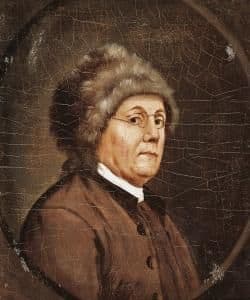
I liked Benjamin Franklin because he reminded me of my grandfather, who also was smart, philosophical, an engineer, and he also liked to invent things. Plus, how cool is it that Ben Franklin went out in a thunderstorm to fly a kite, and discovered electricity, and that is precisely why I selected “Electricity” for my fifth grade science report.
————
Fifty years later, a French friend told me that her two 10-year-old twins were studying American History, and how they had learned that the Native Americans and the Europeans had a “disagreement!” We both laughed in unison. It reminded me of my own shallow introduction to American history. After that conversation, I stumbled upon a blurb about Benjamin Franklin, a quote from his autobiography, which struck me as remarkably generous by today’s practices and standards:
“As we enjoy the advantages from the inventions of others, we should be glad of an opportunity to serve others by any invention of ours; and this we should do freely and generously.”
This prompted a further search for information about Franklin. Within moments, I discover articles that discusses his many mistresses, 15 illegitimate children, and a letter he wrote in 1745 to a young man seeking advice for his insatiable libido. Franklin entitles his response letter, “Advice to a Young Man on the Choice of a Mistress.” He goes on to explain that with older women they tend to have more discretion, will take care of you when you’re sick, are cleaner than prostitutes, and that “there is no hazard of children.” He also offered that one couldn’t really tell who’s old, or young, when you’re in the dark.
I learned that Franklin’s dalliances in both England and France earned him the honor of a rhyme:
Franklin, tho`plagued with fumbling age
Needs nothing to excite him.
But is too ready to engage
when younger arms invite him.
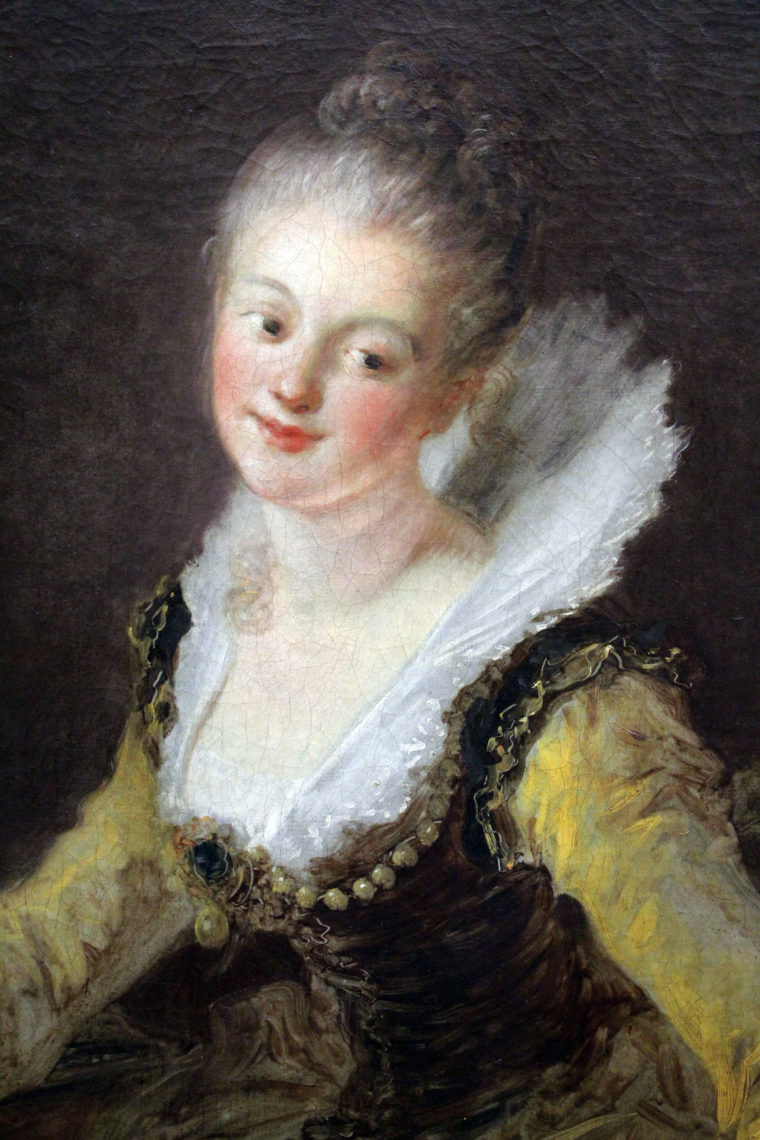
Especially amusing, was the pet name given to Franklin by his young French friend, Anne-Louise Brillon de Jouy, referring to him as, “Cher Papa!”
This bit of salacious news inspired me to keep poking around Ben’s life which led me to the Pilgrims, Massachusetts Bay Colony, the Native Americans, and the onset of slavery, the American Revolution, and some very interesting discoveries.
Soon I found a discussion of Franklin as a slave owner. Given our recent social awareness of the #Me Too Movement, all the purported political scandals with our current President, and most recently, the George Floyd Murder/Black Lives Matter protests, it seems like a very worthwhile activity to re-consider my childhood introduction to our national “creation myth,” and the circumstances that contributed to shaping our nation’s Constitutional Cher Papa!
God, King, & Country!
Of course, the English were not the first European power to invade the Americas, nor where the English as enlightened as they self-anointed themselves to be when arriving. Intoxicated by their own since of entitlement, centuries of power grabs, infighting, and “kingdom” formulation had bred a very specific kind of human being: one who believed they were ordained by God to enslave and kill other human beings that they deemed “savages,” and were impervious to the rich cultures of those they subjugated.
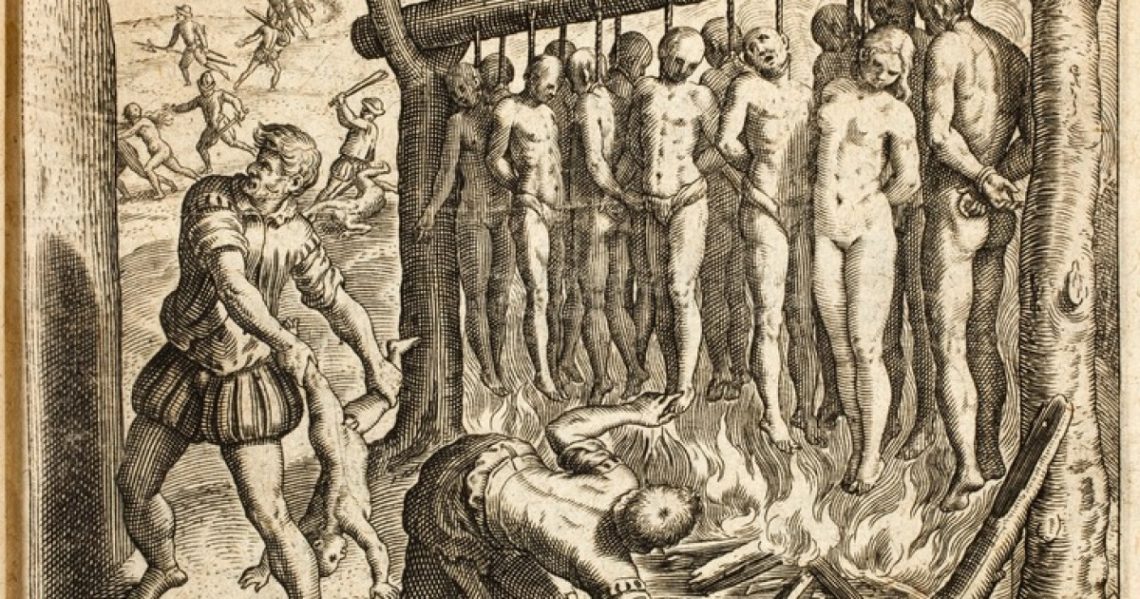
The Spanish began their violent conquests of the Americas in the 1500s, arriving first in the West Indies, then Mexico, Peru, Paraguay, Colombia, and the Caribbean. They then moved north and established communities in St. Augustine, Florida in 1565, and arrived to Santa Fe, New Mexico in 1595. The French and English both arrived in early 1600s. The French to the North, founded Quebec in 1608, and the English to the South founded Jamestown Colony in 1607. The Pilgrims arrived to Massachusetts in 1620 on the Mayflower.
Ben Franklin’s father, Josiah, was born in England during the reign of James I of England (James VI of Scotland, same King). King James was ruler of both Scotland and England, both with individual sovereign states, their own parliaments, judiciaries, and laws. This must have paved the way for Massachusetts Bay Colony and the Virginia Colony to have distinctly separate governances, but the same allegiance to their King.
It is important to consider that both of the first British colonies were created as a financial investment scheme back in England. The London Company (also called the Virginia Company of London) was an English joint-stock company established in 1606 by royal charter by King James I with the purpose of establishing colonial settlements in North America.
The other being The Massachusetts Bay Colony was founded by the owners of the Massachusetts Bay Company, which included investors in the failed Dorchester Company which had established a short-lived settlement on Cape Ann in 1623. The colony began in 1628 and was the company’s second attempt at colonization.
America, as we like to refer to ourselves, began as a backroom gamble among the British elite, with the actual settlers being a confluence of financial ambitions, religious exodus from persecution, with the hope for ownership of land, and more independence from the laws and caprice of a monarchy.
Interesting Historic Sidebar:
King James I, was born a Catholic, but became a Protestant/Anglican, and commissioned one of the most significant contributions to Anglo-Saxon rule and control –The King James Bible Version.
The translation was done by 6 panels of translators by 47 men in all, most of whom were leading biblical scholars in England.
Interestingly, the King James Bible was not the first bible printed in the New World. The first Bible printed on American soil was John Eliot’s Algonquin Indian language Bible, which came off the press in 1663, and again in 1685.
The first edition of Saur’s German Bible came off an American press in 1743. The first English language Bible was printed in America, 1782.
The “King James Version” of the Bible was still arguably the “copyright” of the English Crown, since “Public Domain” laws were not yet commonplace.
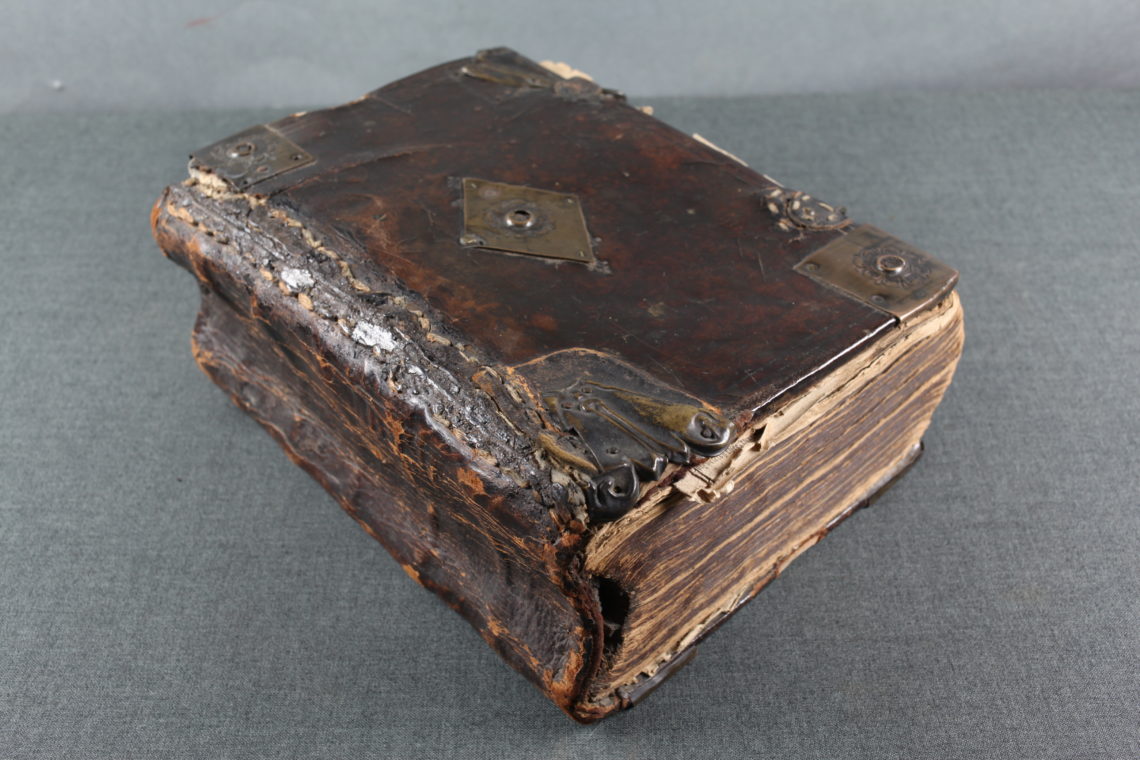
The State of the Union
The 17th century was a period of huge political and social upheaval. From an age characterized by the Crown’s tight control of the state, the century witnessed years of war, terror and bloodshed that enveloped the kingdom, as well as the execution of Charles I and the introduction of a republic.
• 1625 Anglo-Spanish War
• 1627 Anglo-French War
• 1639 Bishop’s War (Against Scottish Royalists)
• 1640 Portuguese Restoration War
• 1641 Irish Confederate Wars
• 1642 English Civil War
• 1652 First Anglo-Dutch War
• 1654 Anglo-Spanish War
• 1665 Second Anglo-Dutch War
• 1672 Third Agno-Dutch War
• 1685 Monmouth Rebellion
• 1687 Anglo-Siamese War
• 1688 Nine Years’ War
The vast majority of people in Stuart Britain resided in agricultural villages, while the rest lived in the towns and cities. These were typically crowded and insalubrious, especially in the most congested city, London.
Wealthier merchants, whom we would today tend to classify as middle-class, largely prospered during the Stuart period. In the 1670s, in the latter part of the Stuart period, William Petty published Political Arithmetick, in which he wrote:
“The whole kingdom grows every day poorer and poorer; that formerly it abounded with gold, but now there is a great scarcity both of gold and silver; that there is no trade nor employment for the people, and yet that the land is under-peopled; that taxes have been many and great; that Ireland and the plantations in America and other additions to the Crown, are a burthen [burden] to England; that Scotland is of no advantage”.
Life expectancy during this period was generally a good deal shorter than in the present day. The child mortality rate was very high, and childbirth was a dangerous and potentially fatal event for the mother, too: if the trauma of birth didn’t kill her, infection could days later.
People in Stuart Britain enjoyed a variety of pastimes, including country dances, singing and listening to live music, going to see a play at the theatre, and witnessing the gory spectacle of blood sports including cock-fighting and bear-baiting.
During the Stuart period some ‘exotic’ foods and beverages began to make their way into Britain. Instead of being confined to local and sometimes European trade, Stuart Britain was able to trade in a global marketplace the likes of which had never been seen before: furs from North America, tea from China, and everything in between meant that some truly fascinating new tastes tantalized the British palate. In 1633, bananas were sold in London for the first time, and coffee and tea became so popular that the first coffeehouses opened – these were seen as veritable dens of political dissent and intrigue.
Coffee was considered a man’s drink, and women weren’t welcome in coffeehouses. Tea, on the other hand, was regarded as more of an aristocratic ladies’ drink, whereas hot chocolate (which also appeared for the first time in Britain during the 17th century) was a luxury enjoyed by both sexes in the upper echelons of society.
Although England renounced religious persecution in 1689, it persisted on the European continent. The persecutions were so long lasting and bloody that the resentments lasted generations, and arrived with the settlers.
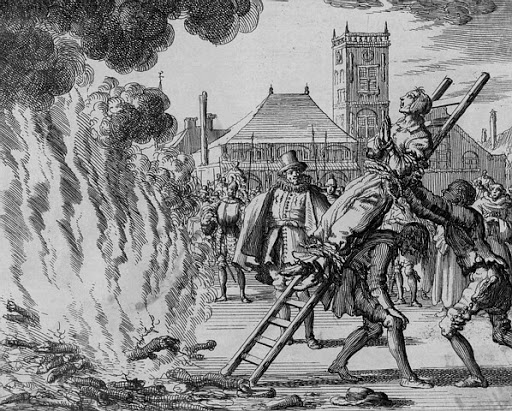
As the various outbreaks of plagues began to subside in England, there was a continuous rise in the British population, causing great poverty among the common people. Most of the common folk tended to be illiterate and to work for a ‘master.’ Some historians estimate two-fifths of the labor force. It could be said that England—for the common man—when colonizing America, already lived as a nation of indentured people and slaves. Yet a far more nefarious enslavement, that exceeded the plight of the poor caucasian European, occurred when the first ship of British privateers reached the Virginia Colony with 20-30 stolen African slaves in 1619.
Massachusetts Bay Colony
In England, under King James I, the Pilgrims had experienced torture and execution to conform to the will of the monarch. King James was unwilling to reform the Church of England. The group’s practice of allowing consensus of the entire group, threatened the authority of the English church and crown.
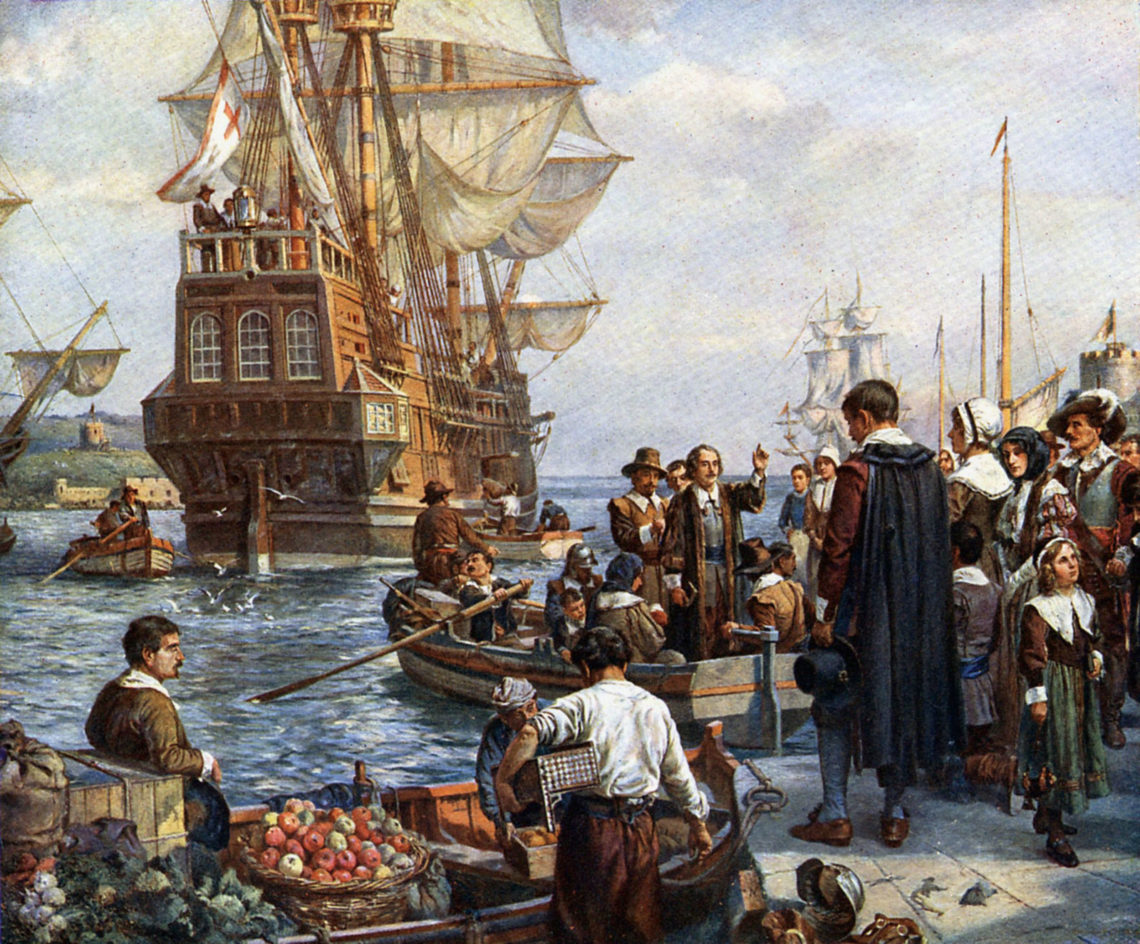
The Pilgrims first left England, and traveled to Amsterdam, followed by a permanent move to Leiden, Belgium where they were given safe shelter to practice their religious beliefs and work. They remained for almost 12 years. With the Dutch possibly entering war, the Pilgrim’s vote to sail to the New World.
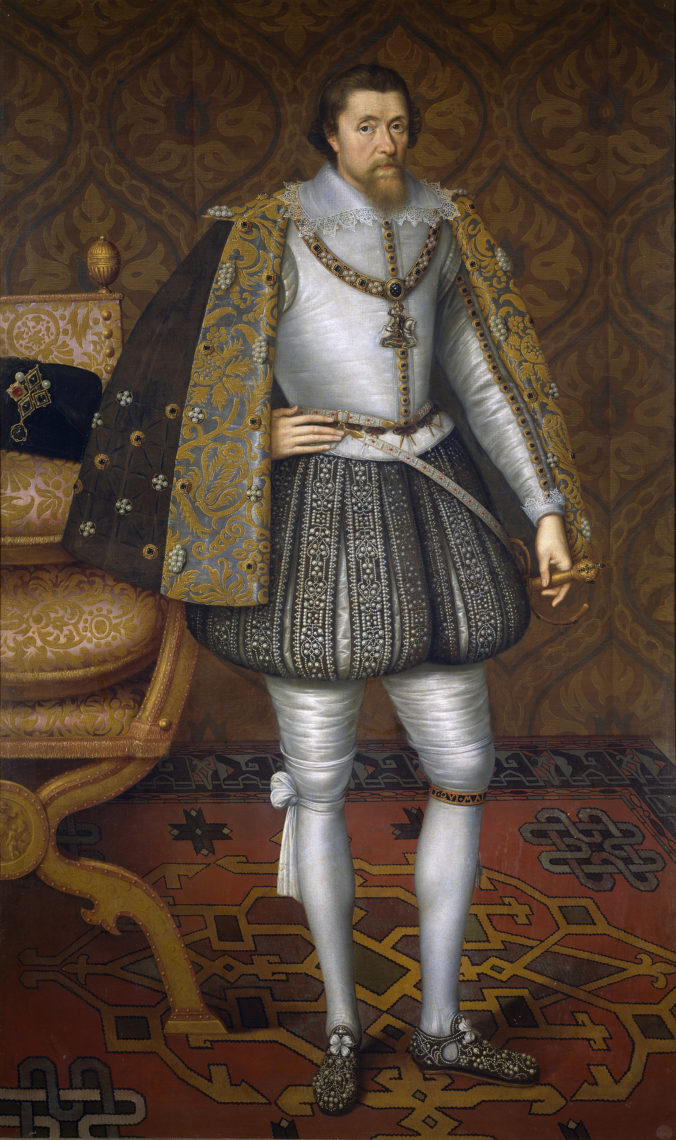
Portrait attributed to John de Critz, c. 1605
They bought a boat, The Speedwell and rented a freighter named, The Mayflower. The Speedwell was detoured by a storm, and sprang three different leaks, and was detained! The overcrowded Mayflower decided to sail alone.
In the middle of the voyage, there was a violent storm and the ship was seriously damaged. One of the passengers happened to have an iron jackscrew, that he intended to use for his new home in America, and they were able to patch the ship sufficiently to sail onward. A child was born on the ship before reaching landfall, a boy, they named, Oceanus. Sadly, he didn’t survive the first winter. (Had he survived he would have been my 9th great-grandfather.)
Nov 9, 1620, after 65 days at sea, they reached the shore. A storm blew them off course, pushing them farther north. They had intended to reach the Hudson River Valley, in the Virginia Territory. This inspired some of the non-Puritan passengers (whom the Puritans referred to as ‘Strangers’) to proclaim that they “would use their own liberty; for none had power to command them.” To prevent disharmony, the Pilgrims determined to establish their own government, while still affirming their allegiance to the Crown of England. They all agreed upon what we today refer to as the Mayflower Compact.
Reverend John Winthrop delivered a sermon before he and his fellow settlers reached New England. The sermon is famous for its use of the phrase “A City on a Hill,” used to describe the expectation that the Massachusetts Bay colony would shine like an example to the world.
Upon arrival to shore, on November 15, 1620, the men fell to their knees and thanked God. They begin in prayer and gratitude, and searched for a location suitable to begin the settlement. It is already too cold to begin construction. They were most afraid of “The Natives.” Back in England, they heard horror stories, and saw Spanish illustrations of natives eating human captives.
As the Pilgrims explore the coast, they find human skulls and remains along the coastline. They search further and find stashes of corn that the Natives left as their seed pit storage for winter, to be used when they returned in spring for planting.
The Men are exhausted and disheartened by what they think is a country of empty, sandy land, with no fertile soil. When they return to the ship, William Bradford’s wife, Dorothy, has fallen overboard and drowned.It is already getting bitterly cold, so the passengers remain onboard the Mayflower, suffering an outbreak of a contagious disease described as a mixture of scurvy, pneumonia, and tuberculosis. Fifty percent of the passengers and crew died in the first winter. Bradford falls ill. They hear strange cries at night. Still, no one has actually seen a Native, but they know that they are being watched.
By spring, on March 21, 1621, only 53 have survived the winter. The party goes ashore to begin building their new lives.
First Contact
When the immigrants set sail for the New World, many of them believed that they would be settling what Pilgrim William Bradford called “a vast and unpeopled country.” But when they arrived in America, they found a developed region with a large population of Native Americans.
“Massachusetts” is an Algonquian Indian word? It comes from the Wampanoag word Massachuset, which means “By the Range of Hills.”
Colonists first encountered the Wampanoag, followed by the Massachusett, Nipmuck, Pennacook, Penobscot, Passamaquoddy, and Quinnipiac. Later, in southern New England they met the Mohegan, Pequot, Pocumtuc, Podunk, Tunxis, and Narragansett.
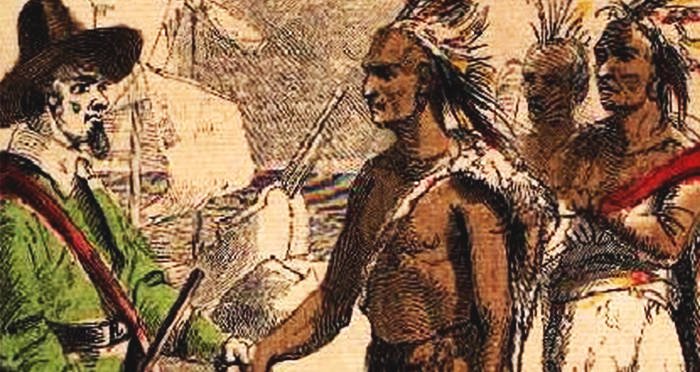
The first Native American to enter the camp was a man named, Samoset from the Abenaki Tribe. He was a tall, striking looking man. As he entered camp, he opened his arms welcomingly and said, “Greetings Englishmen!” He then asked for bread and beer. I’m sure the settlers were both stunned and delighted that their fear and dread of the “Natives” vanished by Samoset’s disarming charm and grace.
Samoset tells the settlers of another native that speaks even better English than himself, named Tisquantum, or “Squanto” of the Wampanoag Confederacy. He had learned English from English Cod fishermen. Chief, Massasoit Sachem, or “Great Sachem” leader of the Pokanoket sent him.
Squanto is a fascinating person who is directly responsible for teaching the settlers how to survive. Moreover, as the only Native who speaks English with any amount of fluency, he is able to represent their case to Massasoit Sachem, who he tells the chief of the Europeans superior firepower, and deadly diseases that are “stored in barrels.”
Squanto teaches the settlers how to grow corn by planting it with decaying fish in mounds to maintain moisture, how to fish for lobster, and gather other seasonal food sources. He assists in establishing the critical trade relationships with other tribes, trading beaver furs for simple knives, or beads, Wampum. This assures the colony’s economic survival.
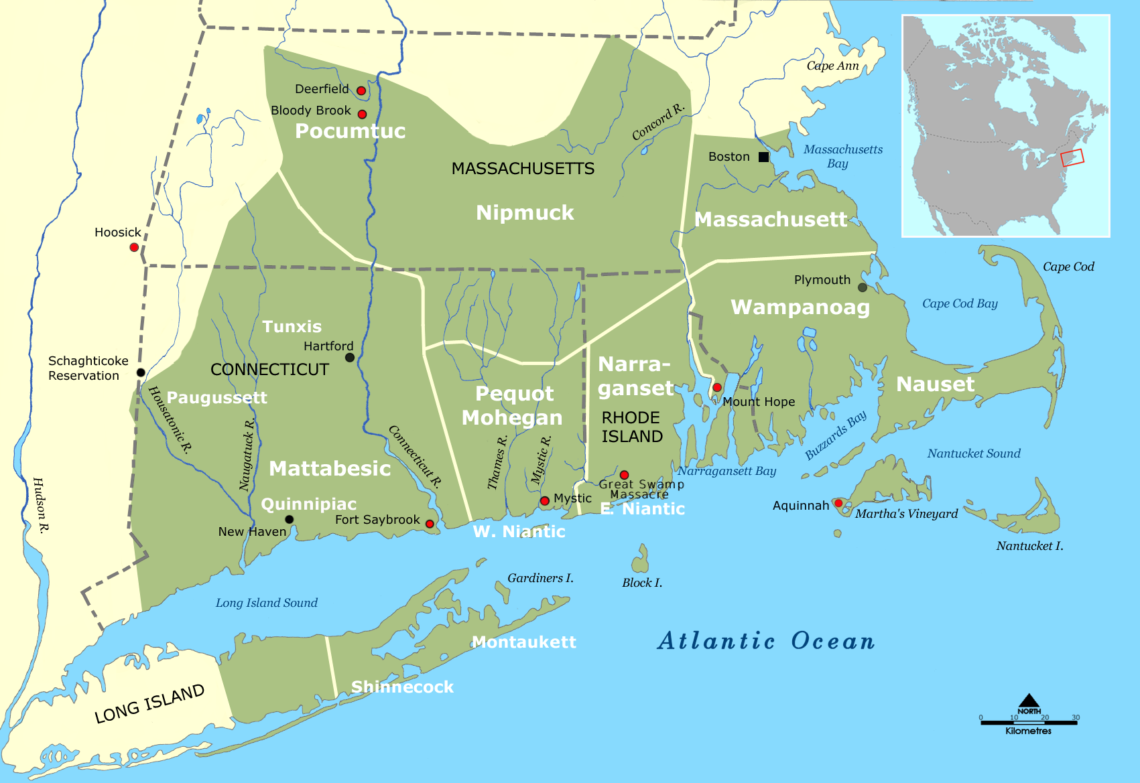
Interestingly, before meeting the Pilgrims, Squanto was captured and sold into slavery in Spain. He finds his way to England, and after several years finds his way home. In his absence, his people and his entire family die from disease brought by other Europeans. The very bones the settlers found on the beach, and build their new homes upon, are the remains of his family, yet he continues to help the European arrivals to survive.
The new settlers sign a treaty with Massasoit Sachem, which he kept his word faithfully until his death. It is with great certainty that without the assistance of Massasoit Sachem, Samoset, and Squanto, the Plymouth colony would have been destined for certain death.
Colonial Growth
In 1631, the Massachusetts Bay Colony’s governor, John Winthrop, expanded the franchise to all free adult males in the colony. These men voted for their representatives to the General Court (their legislature), who then voted for the governor and his council of assistants. None of these elected officials were clergymen, because no minister was allowed to hold political office.
But the Puritans didn’t leave England to create a society where all religions would be tolerated. They sought religious freedom only for themselves. They didn’t hate the Natives; they hated Catholics, and other groups like Quakers, or the Anabaptists.
The Puritans believed that God had formed a unique covenant, or agreement, with them. They believed that God expected them to live according to the Scriptures, to reform the Anglican Church, and to set a good example that would cause those who had remained in England to change their sinful ways. The Puritans truly believed that if they honored God, their colony would be blessed and succeed, and if they failed to honor God, their colony would be punished. This obsession with honoring God made American Puritanism a very strict, severe religious movement.
Writing in 1634 from Boston, less than four years after the city had been founded, Winthrop described a population of 4,000 settlers “well provided of all necessarys.” The American Indian population did not fare as well. Epidemic diseases introduced by European fishermen and fur traders reduced the population of New England’s coastal tribes by about 90 percent by the early 1620s. Their numbers continued to dwindle after Winthrop’s colony arrived in 1630, a development he took as a blessing:
“For the natives, they are near all dead of the smallpox, so the Lord hath cleared our title to what we possess.”
The years 1630 to 1640 are known as the Great Migration. The major centers of the new colony were the eastern coastal Massachusetts towns of Boston and Salem. During this time, an estimated 200 ships reportedly carrying approximately 20,000 people arrived in Massachusetts.
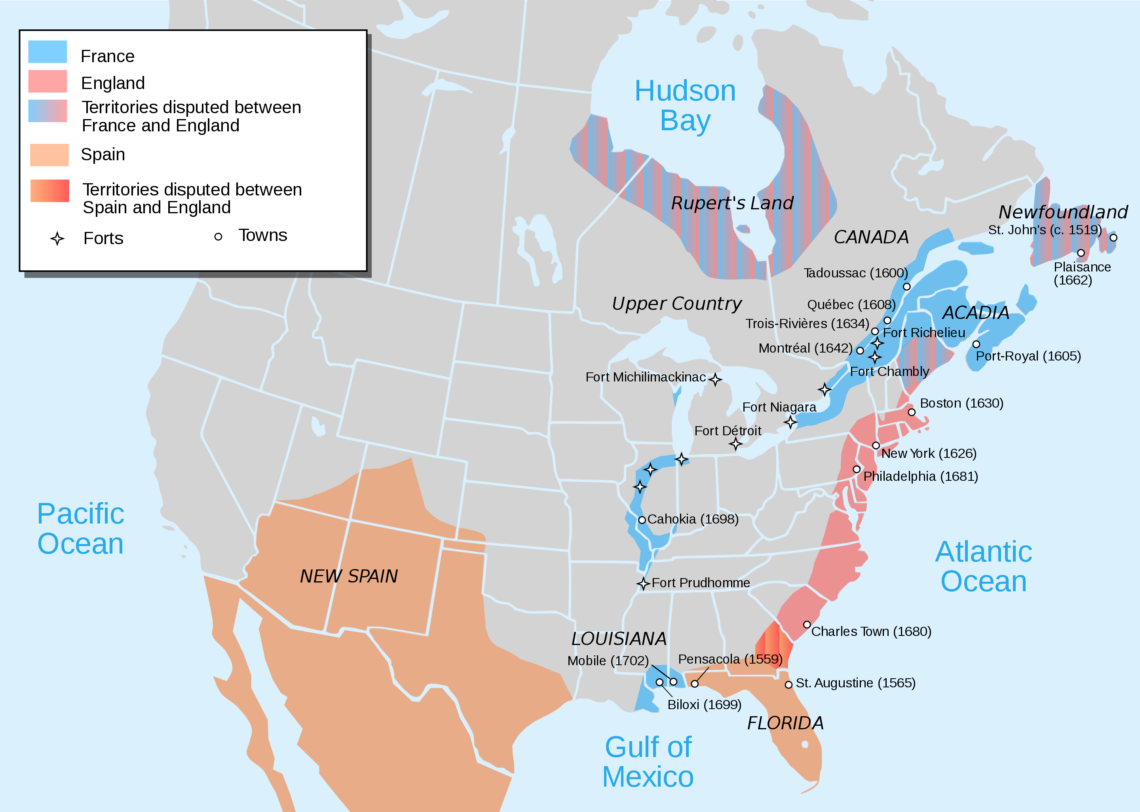
Puritan minister Increase Mather, believed that the illness and decimation of the New England Native Americans was an act of God to support the colonists’ right to the land: “About this time [1631] the Indians began to be quarrelsome touching the Bounds of the Land which they had sold to the English, but God ended the controversy by sending the Smallpox amongst the Indians.”
Some colonial governments used the devastation as a way to convert the natives to Christianity, making them into “Praying Indians” and moving them to “Praying Towns,” or the first Native American reservations.
In 1636-1637 the Pequots fought and lost a war with the English, who enslaved Native people they took captive. In the Pequot War, which lasted 11 months between 1636 and 1637, thousands of Pequot were killed and their villages were destroyed. The Pequots resisted enslavement, however, and frustrated that the Indians would “not endure the yoke,” the Puritans sent them to Bermuda in exchange for African slaves.
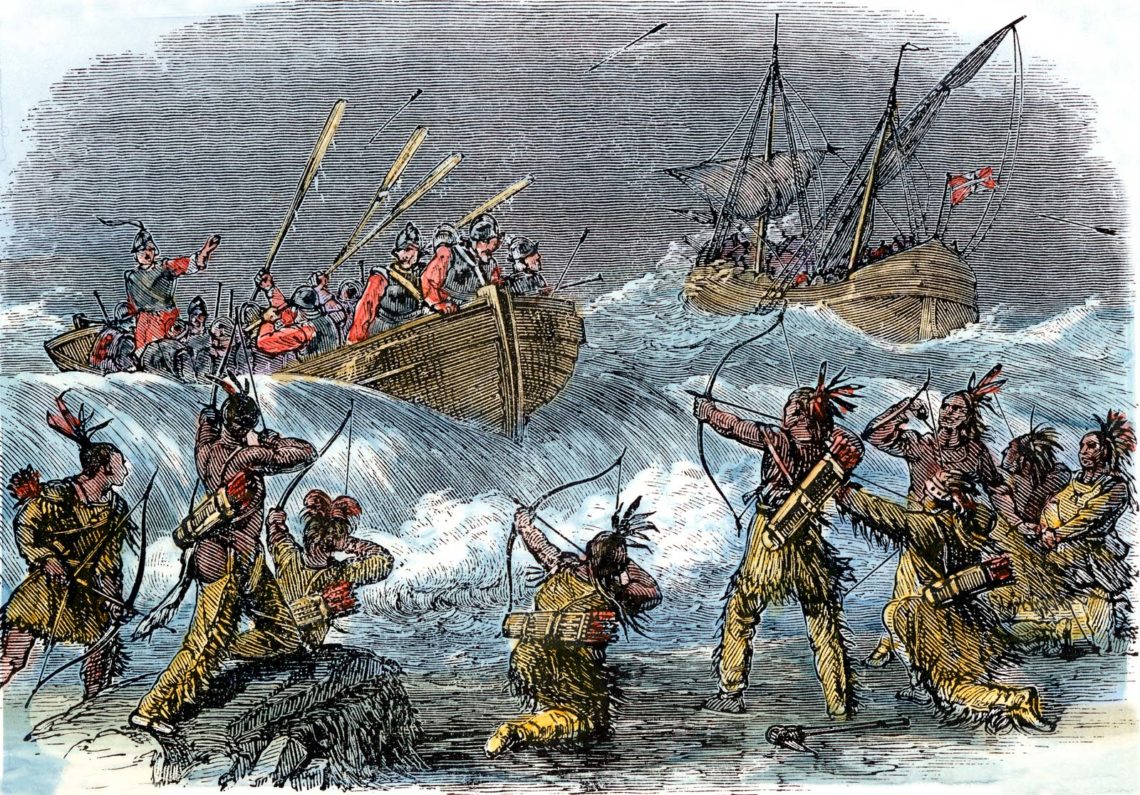
In 1641 Massachusetts Bay Colony was the first of Britain’s mainland colonies to make slavery legal.
On February 28, 1638, the governor of the Bay Colony noted in his journal that a ship arriving from Bermuda had enslaved Africans aboard. “Mr. Pierce, in the Salem ship, the Desire, returned from the West Indies after seven months. He . . . brought some cotton, and tobacco, and Negroes.”
By 1704, two years before Benjamin Franklin is born, there are more than 250,000 Slaves in America.
Massachusetts Bay Colony became the first English chartered colony whose board of governors did not reside in England. This independence helped the settlers to maintain their Puritan religious practices without interference from the king. England had difficulty enforcing its laws and regulations in the colony, as it was a joint-stock colony that was unlike the other royal colonies, and proprietary colonies that the English crown administered.
In 1660, Charles sought to extend royal influence over the colonies, which Massachusetts resisted along with the other colonies. Parliament passed legislation collectively called the Navigation Acts that attempted to prevent the colonists from trading with any nation other than England.
Colonist-Native American relations worsened. In 1675, the government of the Plymouth Colony executed three members of the Wampanoag people. The Wampanoag leader, Metacom, known as King Philip, retaliated and wanted to drive the English off their lands once and for all. He led the Wampanoag, Nipmuc, Pocumtuc, and Narragansett warriors in the fight. They were outnumbered, and overpowered by the European settlers. The conflict became known as King Philip’s War, and marked the last major effort of Native Americans to drive English settlers out of New England.
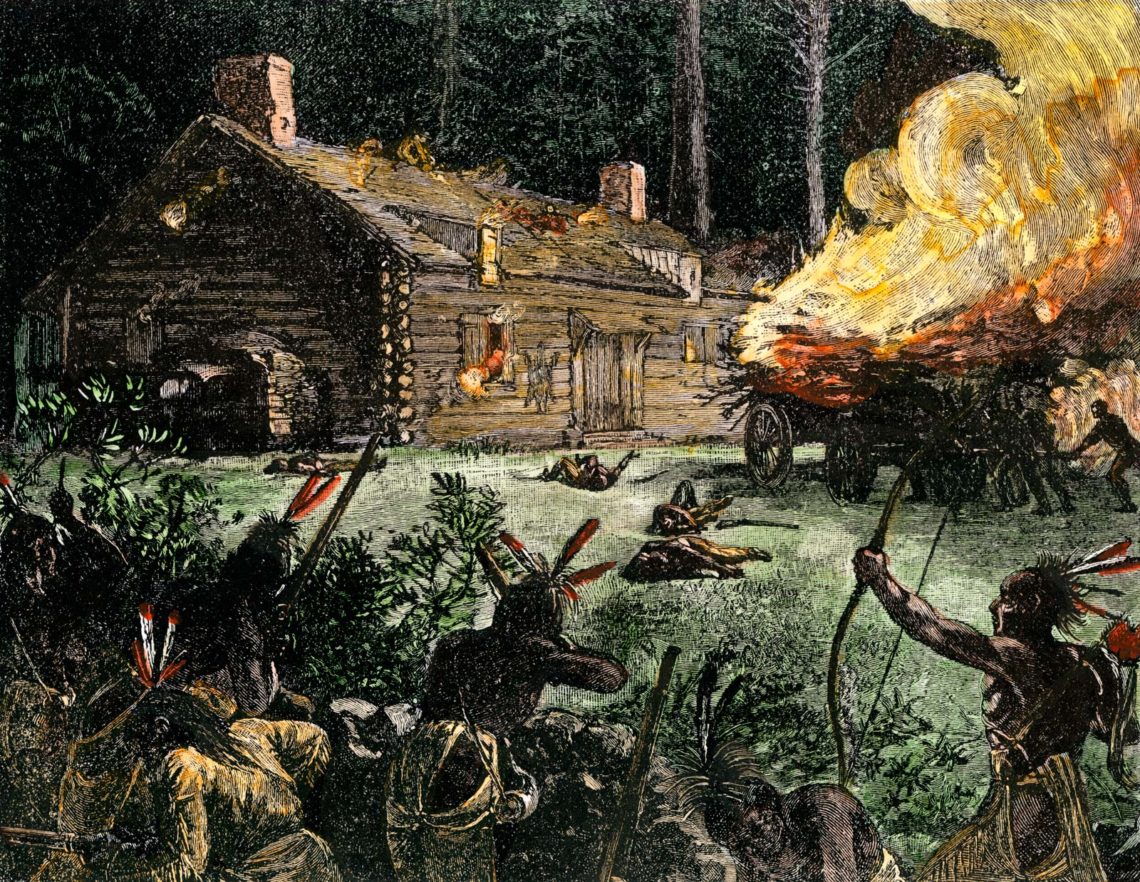
© North Wind Picture Archives
TRADE
The colonies had no currency, no infrastructure, and therefore trade was one of the first bridges between New England colonists and local Native American populations. For the colonists, it was about building the infrastructure and relationships they would need to stay and thrive in the New World. For the Native Americans, it was often about building potential alliances. After only five years, the Plymouth Colony was no longer financially dependent on England due to the roots and local economy it had developed with the native Massachusetts peoples.
The Native Americans provided skins, hides, food, knowledge, and other crucial materials and supplies, while the settlers traded beads and other types of currency (also known as “wampum”) in exchange for these goods.
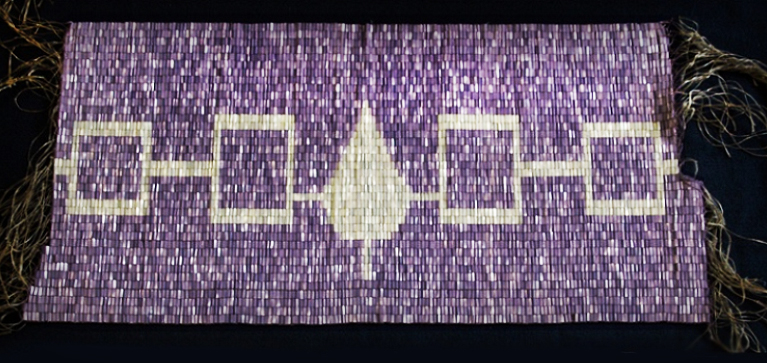
Squanto also helped translate between English and Native American languages, and to negotiate peace with local Native American chiefs.
The New England colonies were on the periphery of the English Empire. They didn’t bring cash like the crops in the Virginia colony. They were not very profitable in and of themselves. But they were able to assist in the very important sugar market in the West Indies.
The Plymouth colonies sugar and tobacco all came from the West Indies, which relied on African slaves for labor.
An ever-increasing numbers of African slaves were being imported into these islands to add in the production of sugar, which is making immense profit. It was a brutal toll on the enslaved work force. It killed these workers at alarming rates: often above 50 % mortality.
The first anti-slavery publication in Boston was published in 1700. It was called, “The Selling Of Joseph” by Samuel Sewall. He was a wealthy merchant and Chief Justice of the Massachusetts Superior Court. He said that the growing numbers of African slaves in Boston troubled him, and he questioned the validity of the practice. He clearly ruled that this is not God’s work to bring African slaves, we’re not helping them, and it’s morally wrong.
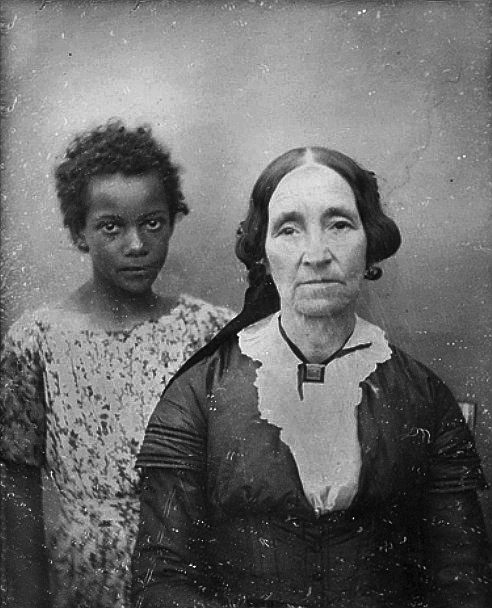
A man named John Saffin responds with his rebuttal. Saffin maintains that there is a hierarchy in the world. God developed this hierarchy. Some people are born to serve, and these slaves are those very people, and the Bible justifies this.
Moreover, he says it’s not wrong to take them from Africa because we’re “Christianizing” them. We are, in fact, saving them.
Social freedom
Many colonists thought it was important to preserve class distinctions. Because of this, they passed many sumptuary laws that proscribed what members of the different classes could purchase, or own.
In America, as in England, plain dress and rich dress became, in effect, the respective symbols of the Puritan and the Cavalier, respectively. Many Virginia colonists leaned toward the Cavalier; Puritan ideas prevailed in Massachusetts.
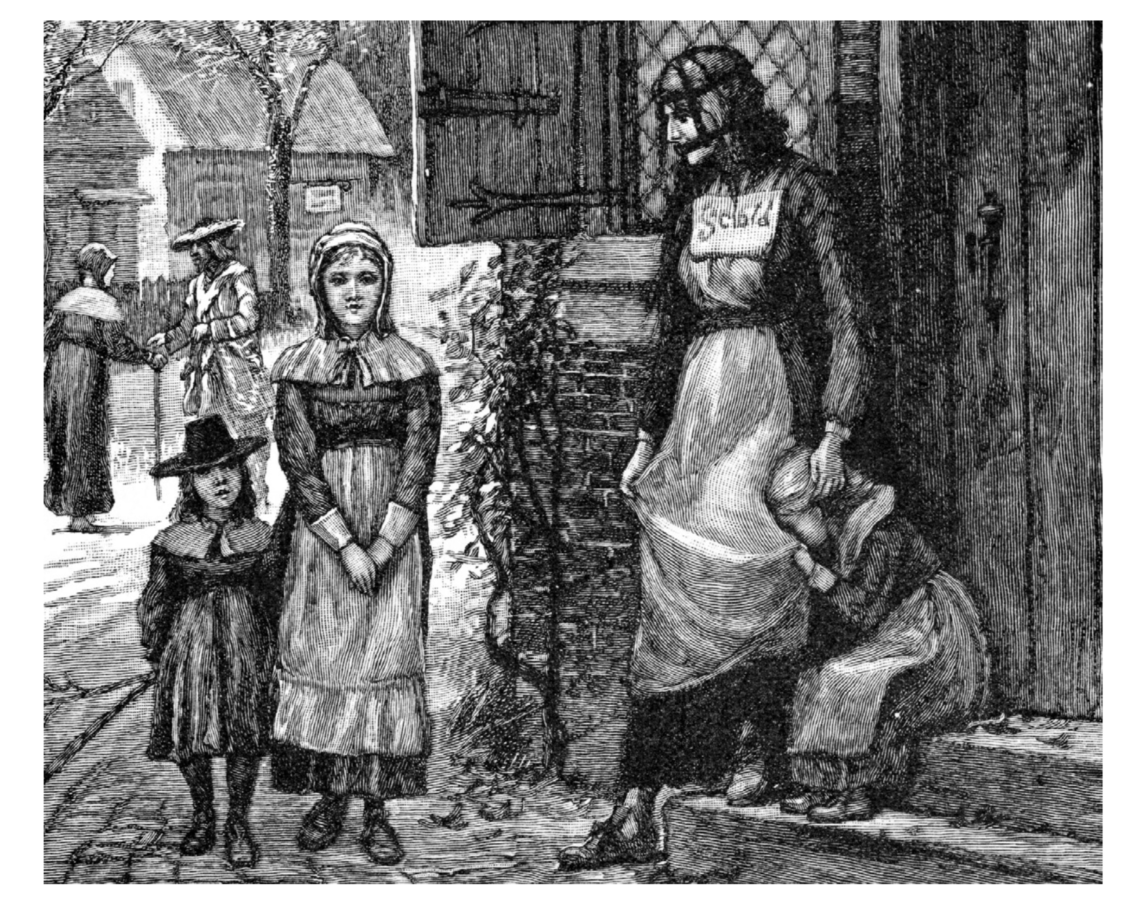
In colonial America, sexual activity was to be confined to marriage. Sex outside of marriage was considered fornication, if neither partner was married, and adultery, if one or both were married to someone else. Fines, and pressure to marry generally punished fornication; a woman who gave birth to an illegitimate child could also be fined. Adultery and rape were more serious crimes, and both were punishable by death. Rape, however, required more than one witness, and was therefore rarely prosecuted. Sexual activity between men was called sodomy, and was also punishable by death.
It is often said that New England invented grandparents, for it was here that people in great numbers first grew old enough to see their children bear children.
Puritan ministers furthered the notion of male supremacy in their writings and sermons. They preached that the soul had two parts, the immortal masculine half, and the mortal feminine half.
Church attendance was mandatory. Those that missed church regularly were subject to a fine. The sermon became a means of addressing town problems or concerns.
Adulterers might have been forced to wear a scarlet “A” if they were lucky. At least two known adulterers were executed in Massachusetts Bay Colony. Public whippings were commonplace. The stockade forced the humiliated guilty person to sit in the public square, while onlookers spat, or laughed at them.
Women were bound to obey their fathers and brothers, then their husbands, and then their sons, and had very few rights. They were not allowed to vote, and lost most control of their property (if they had any to begin with) in marriage. They couldn’t divorce, and even single women couldn’t make contracts, sue anyone, or be sued
Mary Dyer was a Puritan woman that converted to become a Quaker. She was the first woman executed for her religious beliefs in Massachusetts Bay Colony for repeatedly defying a Puritan law banning Quakers from the colony.
Anne Hutchinson, in her understanding of Biblical law, she felt the ministers of Massachusetts had lost their way. She thought the enforcement of proper behavior from church members conflicted with the doctrine of predestination. She simply asked, “If God has predetermined for me salvation—or damnation—how could any behavior of mine change my fate?”
Hutchinson claimed that she was a prophetess, receiving direct revelation from God. In this capacity, she prophesied during her trial that God would send judgment upon the Massachusetts Bay Colony and would wipe it from existence. She further taught her followers that personal revelation from God was as authoritative in a person’s life as the Bible, a teaching that was strongly antithetical to Puritan theology. She also claimed that she could identify “the elect” among the colonists. These positions ultimately caused John Cotton, John Winthrop, and other former friends to view her as an antinomian heretic (one who takes the principle of salvation by faith and divine grace to the point of asserting that the saved are not bound to follow the moral law contained in the Ten Commandments).
The clergy felt that Anne Hutchinson was a threat to the entire Puritan experiment. They decided to arrest her for heresy. In her trial she argued intelligently with John Winthrop, but the court found her guilty, and banished her from Massachusetts Bay in 1637.
Education
In the Anglo-American world the Reformation came about in the form of Calvinism—“Puritan” being the derisory name for strict Calvinists. Their ideals were sober, practical behavior, careful management, thrift, asceticism, and the rejection of hedonistic pleasures of life.
The most renowned of the Puritan intellectuals, John Milton, was more concerned with the education of “our nobler and our gentler youth” than with the education of common boys. Of Education (1644), written at the request of Hartlib, was one of the last in the long line of European expositions of Renaissance humanism. Milton’s aim was the traditional one: the molding of boys into enlightened, cultivated, responsible citizens and leaders.
Frequently opposed to Puritanism on educational as well as political grounds were the Royalists and supporters of the nobility. In education, their views went back to Sir Thomas Elyot and Roger Ascham in the tradition of the so-called courtesy books. “Fashioning him, the pupil, absolute in the most necessary and commendable Qualities concerning Mind and Body to country’s glory.” Henry Peacham in his book, The Compleat Gentleman, 1622, we can see what he valued by the table of contents subjects: cosmography, geometry, poetry, music, sculpture, drawing, painting, heraldry, etc.
Benjamin Franklin Enters the New World
To better understand the world that Benjamin Franklin entered, here are a couple of comments from the locals to offer some insight.
First, from Reverend Cotton Mather (from 1702) describing the cities many hardships including ten fires and four Smallpox plagues. He mentions that Boston was proverbially called Lost Town, “…for the mean and sad Circumstances of it.”
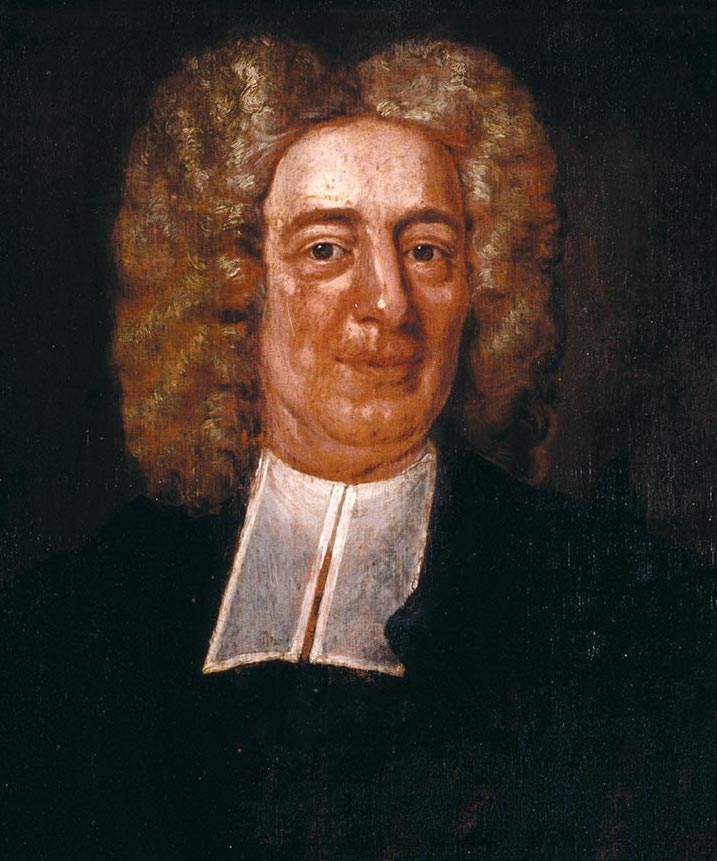
Second, was recorded in 1704, by a Miss Sara Knight, who took a trip on family business to New York and on to visit friends in Connecticut. She clearly feels herself morally and socially superior to most everyone she meets along the way. She tells of an incident, which she clearly finds funny involving a stolen turkey and a “negro slave” who then sells, or gives the turkey, to a “heathen” (Native American). She mocks the make shift courtroom, with the guilty sitting party sitting on “pompions” (pumpkins):
“…The Senior Justice interrogated after the following manner. You, Indian, why did You steal from this man? You shouldn’t do so ⎯ it’s a Grandy wicked thing to steal. Hol’t Hol’t, cries Justice Junior Brother, You speak negro to him. I’ll ask him. You, sirrah, why did You steal this man’s Hogshead? Hogshead? (replies the Indian,) me no stomany. No? says his Worship; and pulling off his hat, Patted his own head with his hand, says, Tatapa⎯You, Tatapa⎯you; all one this. Hogshead all one this. Hah! says Netop, now me stomany that. Whereupon the Company fell into a great fit of Laughter, even to Roaring. Silence is commanded, but to no effect: for they continued perfectly Shouting. Nay, says his worship, in an angry tone, if it be so, take me off the Bench.”
When describing others along the way, she enters the following:
“There are great plenty of Oysters all along by the seaside, as far as I Rode in the Colony, and those very good. And they Generally lived very well and comfortably in their families. But too Indulgent (especially the farmers) to their slaves: suffering [allowing] too great familiarity from them, permitting them to sit at Table and eat with them (as they say to save time) and into the dish goes the black hoof as freely as the white hand.”
…There are everywhere in the Towns as I passed a Number of Indians, the Natives of the Country, and are the most savage of all the savages of that kind that I had ever Seen: little or no care taken (as I heard upon enquiry) to make them otherwise. They have in some places Lands of their own, and Govern’d by Laws of their own making; they marry many wives and at pleasure put them away, and on the least dislike or fickle humor, on either side, saying stand away to one another is a sufficient Divorce. And indeed those uncomely Stand aways are too much in Vogue among the English in this (Indulgent Colony) as their Records plentifully prove, and that on very trivial matters, of which some have been told me, but are not proper to be Related by a Female pen, though some of that foolish sex have had too large a share in the story.”
Benjamin Franklin’s father, Josiah was in Northamptonshire, England, the son of a blacksmith, in 1657. He married, and had eight children. His first wife died, and he moved to Boston in 1682, and married, Abiah Folger who was born in Nantucket, Massachusetts in 1667. Ben’s father became a Tallow Chandler and Soap Boiler (Candle and soap maker), because there was no need for another blacksmith when he arrived. They had another ten children, including Benjamin, born on Milk Street in 1706.
Franklin was born in the best-educated city, wealthiest of the New England colonies, and already in a time in which the spirit of protests was the political tone. There were slaves, who lived with their masters, ate and slept in the home. Abolitionist ideas were already in bloom by the time Franklin was born. There were booksellers, and the finest school in the country was thriving: Harvard University.
During the harsh years of Queen Anne’s War (1703-1713), a long-lived and bitter power struggle exploded between the old-guard Puritan leaders of the Massachusetts Bay colony ⎯ Reverends Increase and Cotton Mather ⎯ and the Royal Governor Joseph Dudley, an American-born Tory appointed to impose more stringent control over the colony.

Portrait by Michael Dahl, 1705
Ben was born a Presbyterian, and his father wanted him to join the church as a minister. Ben attended Boston Latin School for two years, and his formal education ended at age 10. He was then put to work at his father’s shop: in charge of cutting wicks for candles, filling molds, attending the shop and running errands.
At age 12, he became an apprentice to his brother, James, as a printer. His father made him sign an agreement that he would work without pay until he is 21-years old. Three years later, his brother started the first truly independent paper in the colonies, “The New-England Courant.” When he’s not working on his lunchbreak, he takes the time to read and study. He taught himself how to swim by reading a French book on the subject!
When the precocious intern was denied a chance to write a letter for publication, Franklin adopted the pseudonym “Silence Dogood,” and secretly posed as a middle-aged widow, and his brother published it. Soon afterward, she became a subject of conversation around town.
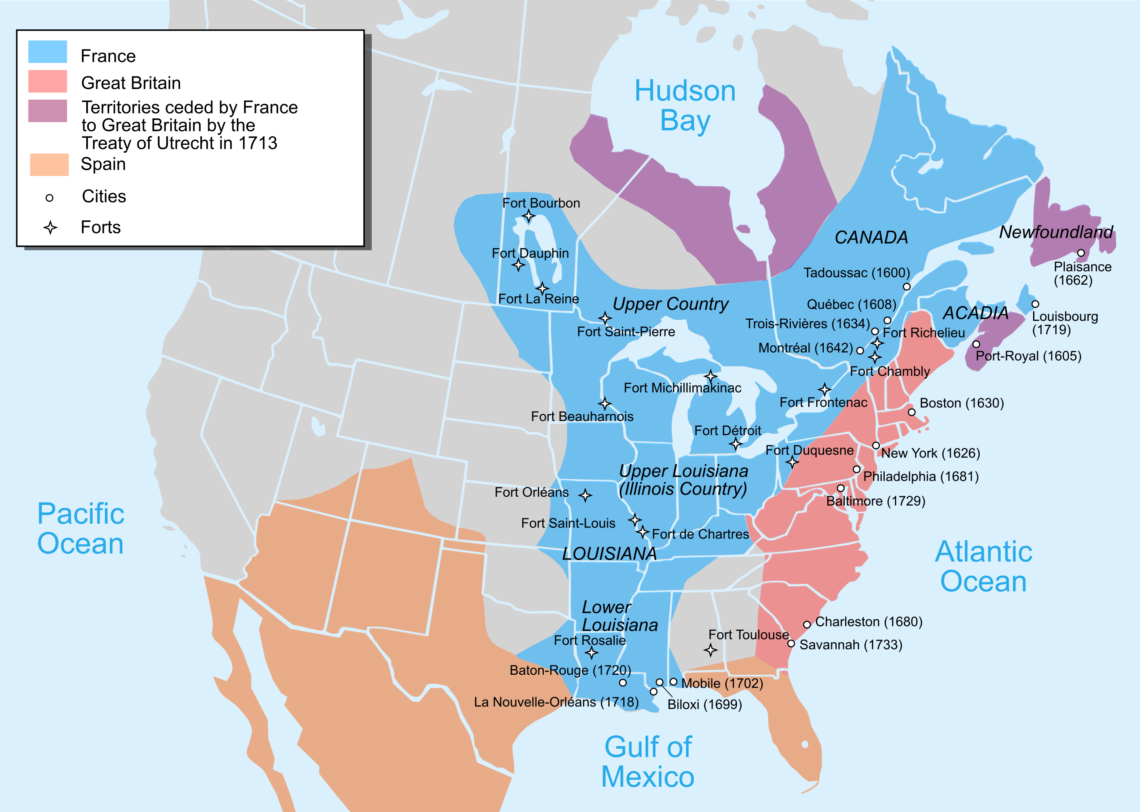
A Letter from a Gentleman from London 1720:
“The Bay of Boston is spacious enough to contain in a manner the Navy of England. The Masts of Ships here, and at proper Seasons of the year, make a kind of Wood of Trees like that we see upon the River of Thames
The Exchange is surrounded with Booksellers Shops, which have a Good Trade. There are five Printing-Presses in Boston, which are generally full of Work, by which it appears that Humanity and the Knowledge of Letters flourish more here than in all the other English Plantations put together; for in the City of New-York there is but one Bookseller’s Shop, and in the Plantations of Virginia, Maryland, Carolina, Barbados, and the Islands, none at all . . .
The Conversation is this Town is as polite as in most of the Cities and Towns in England; many of their Merchants having travelled into Europe, and those that stay at home having the Advantage of a free Conversation with Travellers, so that a Gentleman from London would almost think himself at home at Boston, when he observes the Numbers of People, their Houses, their Furniture, their Tables, their Dress and Conversation, which perhaps is as splendid and showy as that of the most considerable Tradesmen in London. “

by John Bonner
When Ben’s brother, James was jailed for three weeks in 1722 for publishing material unflattering to the governor, young Franklin took over the newspaper and had Mrs. Dogood proclaim:
“Without freedom of thought there can be no such thing as wisdom and no such thing as public liberty without freedom of speech.”
Franklin left his apprenticeship in 1723, without his brother’s permission, and in so doing, became a fugitive, and fled to New York City. With no money, or prospects for work, he soon went on to Philadelphia. At 17-years-old, practically penniless, over the next two decades he would become enormously wealthy as a print shop owner, land speculator, and publisher of the highly prized, “Poor Richard’s Almanack.”
In a time when news took two months to arrive from Europe, the colonists were hungry for news, entertainment, and ideas. Franklin saw the printing press as a device and opportunity to instruct colonial Americans in moral virtue.
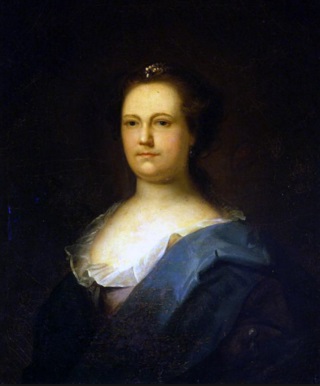
portrait attributed to Benjamin Wilson
In Philadelphia, he meets his future wife, Deborah Read, while boarding at her father’s house. However, shortly after meeting his wife to be, he has an opportunity to work in London, and leaves. Once there, he is stranded for a year, and when he returns, in 1725, he writes and publishes his first pamphlet: “A Dissertation upon Liberty and Necessity, Pleasure and Pain.”
While he was in London he hangs out in coffee houses, and discusses new radical ideas of the “Enlightenment,” with new notions that we are not born to be what we are by birthright or social rank. Instead, one can change one’s fate and become whatever one wants!
At 20, on his return, he is determined to change the direction of his life: he decides to become a “good, serious, and steady man.” Frugal. Apply himself to business: industry and patience. He wants to “move up” and creates a network of local Philadelphia tradesman he names, “The Junto.” Franklin’s colonial version of business networking and a trade school in one!
In two years, he borrows money, and opens his own print shop.
His wife, Deborah, is very practical person, and helps him in the business.
He continues working, and hanging out at coffee houses talking. He has an affair and has an illegitimate son, William born in 1728.
In 1731, Franklin has mixed success with his plan to establish an inter-colonial network of newspapers that would produce a profit for him, and disseminate virtue. He began in Charleston, South Carolina. After the second editor died, his widow Elizabeth Timothy took over, and made it a success, 1738–1746. She was one of the colonial era’s first woman printers.
In 1732, Franklin has another son, Francis Folger. The same year he publishes America’s first German-language newspaper, Philadelphische Zeitung, which soon fails.
This year he also creates Poor Richard’s Almanack, a yearly almanac published by Benjamin Franklin. He adopted the pseudonym of “Poor Richard” from an assumed name, “Richard Saunders.” Almanacs were very popular in colonial America, offering a mixture of seasonal weather forecasts, practical household hints, puzzles, and other amusements.Poor Richard’s Almanack was also popular for its extensive use of wordplay, and some of the witty phrases coined in the work survive in the contemporary American vernacular.
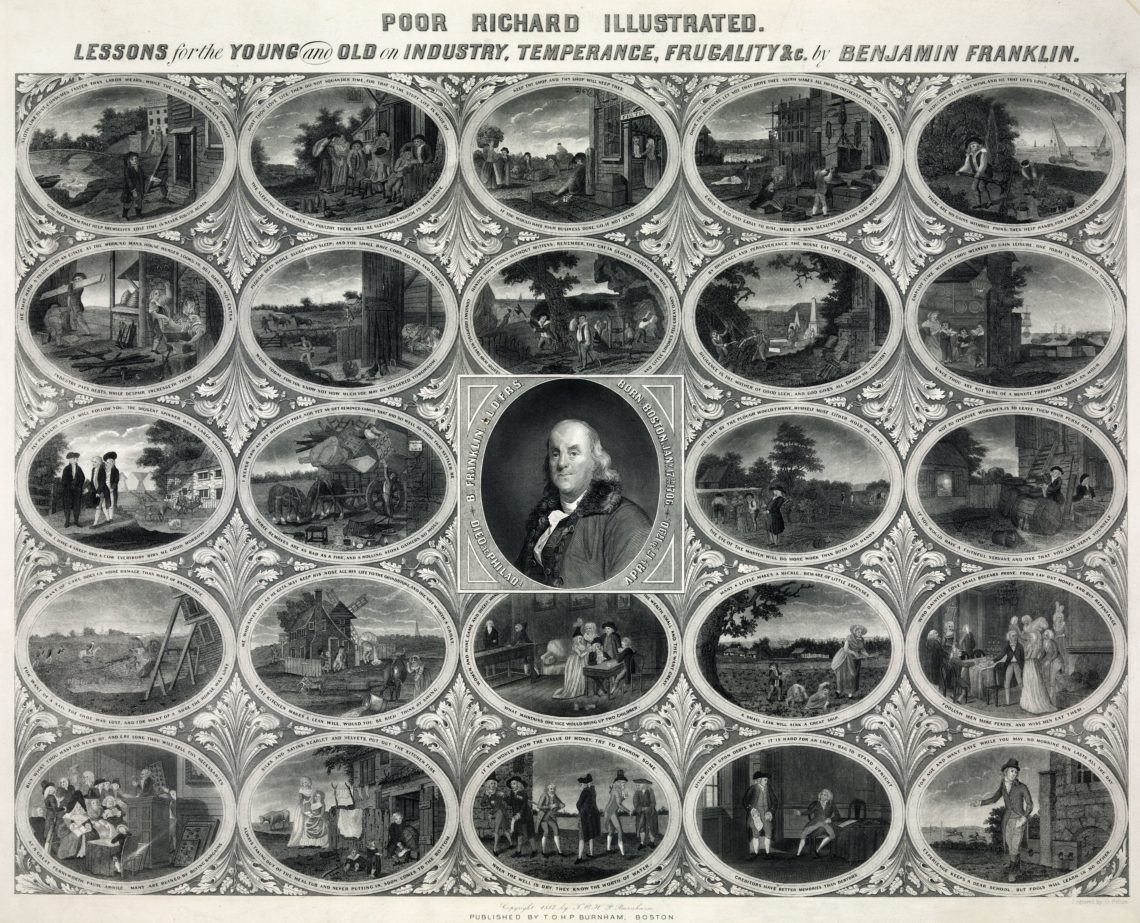
Excerpts from the almanac:
• Love your enemies, for they tell you your faults.”
• “A right heart exceeds all
• “No gains without pains.”
• “Wish not so much to live long as to live well.
By 28-years-old, Franklin seems to be settling down, and is elected Grand Master of the Grand Masonic Lodge of Masons of PA, and two years later he is printing currency for New Jersey.
In 1736 Francis, at 4-years-old, died from an outbreak of small pox. He had not been inoculated. Inoculation had proven successful after the 1721 outbreak in Boston when 5,889 Bostonians had smallpox, and 844 died.
About Francis’s death Franklin wrote in his autobiography:
“In 1736 I lost one of my sons, a fine boy of four years old, by the smallpox taken in the common way. I long regretted bitterly and still regret that I had not given it to him by inoculation. This I mention for the sake of the parents who omit that operation, on the supposition that they should never forgive themselves if a child died under it; my example showing that the regret may be the same either way, and that, therefore, the safer should be chosen.”
The following year, in 1737, he is appointed Postmaster of Philadelphia.
By 1741, we see his first commercial invention come to market, “The Franklin Stove,” which was designed to omit less smoke and offer more heat! The same year he published, “The General Magazine and Historical Chronicle,” one of America’s earliest magazines, but if failed after six issues.
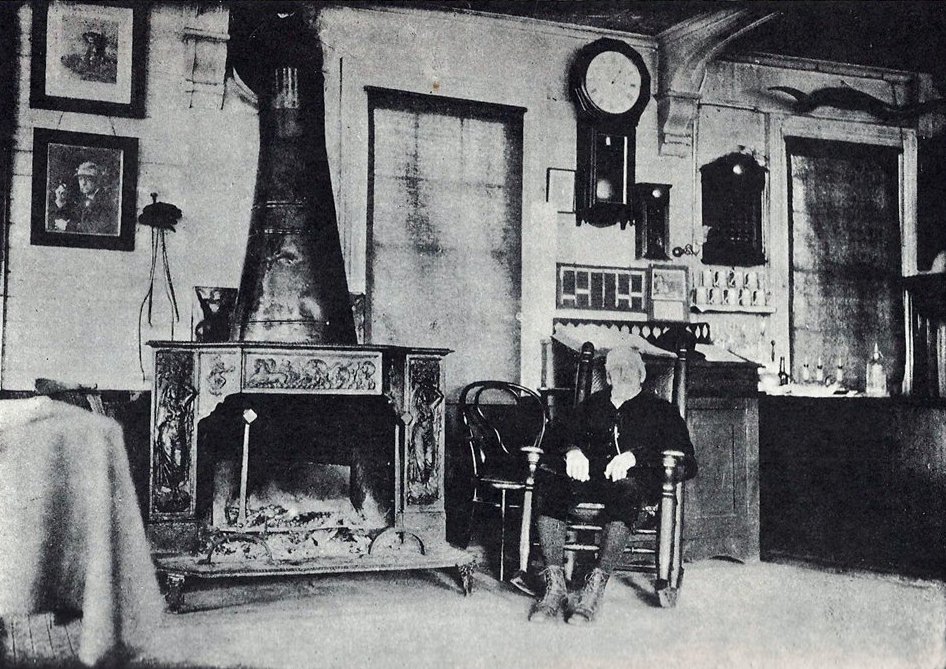
In a 1751 he writes a pamphlet on demographic growth and its implications for the colonies, he called the Pennsylvania Germans “Palatine Boors” who could never acquire the “Complexion” of the English settlers and referred to “Blacks and Tawneys” as weakening the social structure of the colonies. (Franklin apparently reconsidered shortly after publication, and the phrases were omitted from all later printings of the pamphlet.)
Shortly after, The French and Indian War of 1754–1763 broke out. The English allied with the Iroquois Confederacy, while the Algonquian-speaking tribes joined forces with the French and the Spanish. The English won the war, and claimed all of the land in the United States, east of the Mississippi River. Let me repeat that. The colonists won because of the assistance of the Iroquois Confederacy.
Ben has become financially wealthy, a gentleman of leisure by the standards of the day, but instead of relaxing, he uses his time for scientific study, and remains a man of letters. In 1752, he performs his famous “Kite Experiment” at forty-eight-years old. His research led to receiving the Copley Medal of the royal Society of London, and is today attributed with the discovery of electricity.
In the same year, he wrote a plan for a union of the colonies for security and defense, and helped found the Philadelphia Contributionship for Insuring of Houses from Loss Against Fire.
This decade seems to be when Ben Franklin is universally recognized for his genius, both in the colonies and in Europe. He receives honorary degrees from Harvard and Yale universities, and six years later, in 1759, an honorary degree of Doctor of Laws from the University of St. Andrew’s, Scotland.
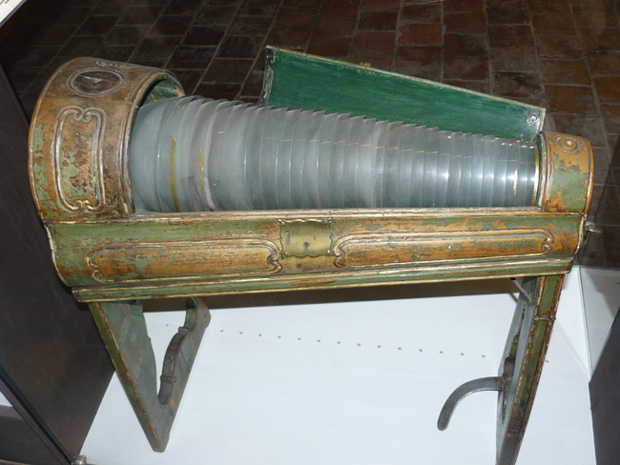
True to his character of balancing public service, and personal creation, in 1762, he both maps the postal routes of the colonies, and creates—what he felt was his greatest invention—the glass armonica: an ingenious musical instrument that has the same affect as running one’s finger over the rim of a crystal wine glass to produce a ethereal sound. In fact, Ben’s instrument captured the imagination of both Beethoven and Mozart whom it is said used the instrument in one of their compositions!
On March 5, 1770, the inevitable happened. A mob of about 60 angry townspeople descended upon the guard at the Customs House. When reinforcements were called, the crowd became more agitated, hurling rocks and snowballs at the guard and reinforcements. In the heat of the confusing melee, the British fired without Captain Thomas Preston’s command. They took the lives of five men, including Crispus Attucks, a former slave. Crispus Attucks was not only the first African American to die for the American Revolution, and he was one of the first patriots to give his life for the cause. The event became known as the Boston Massacre.
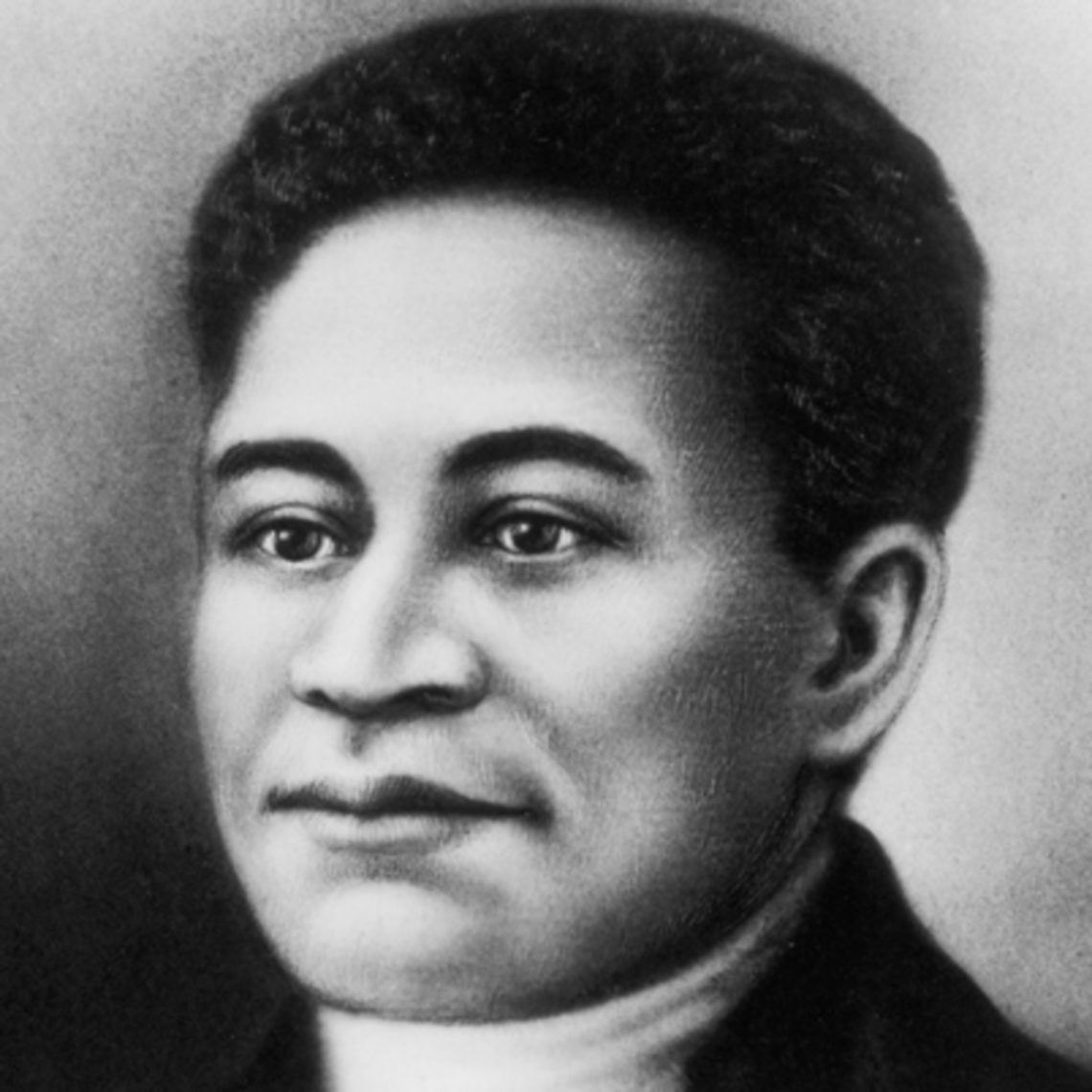
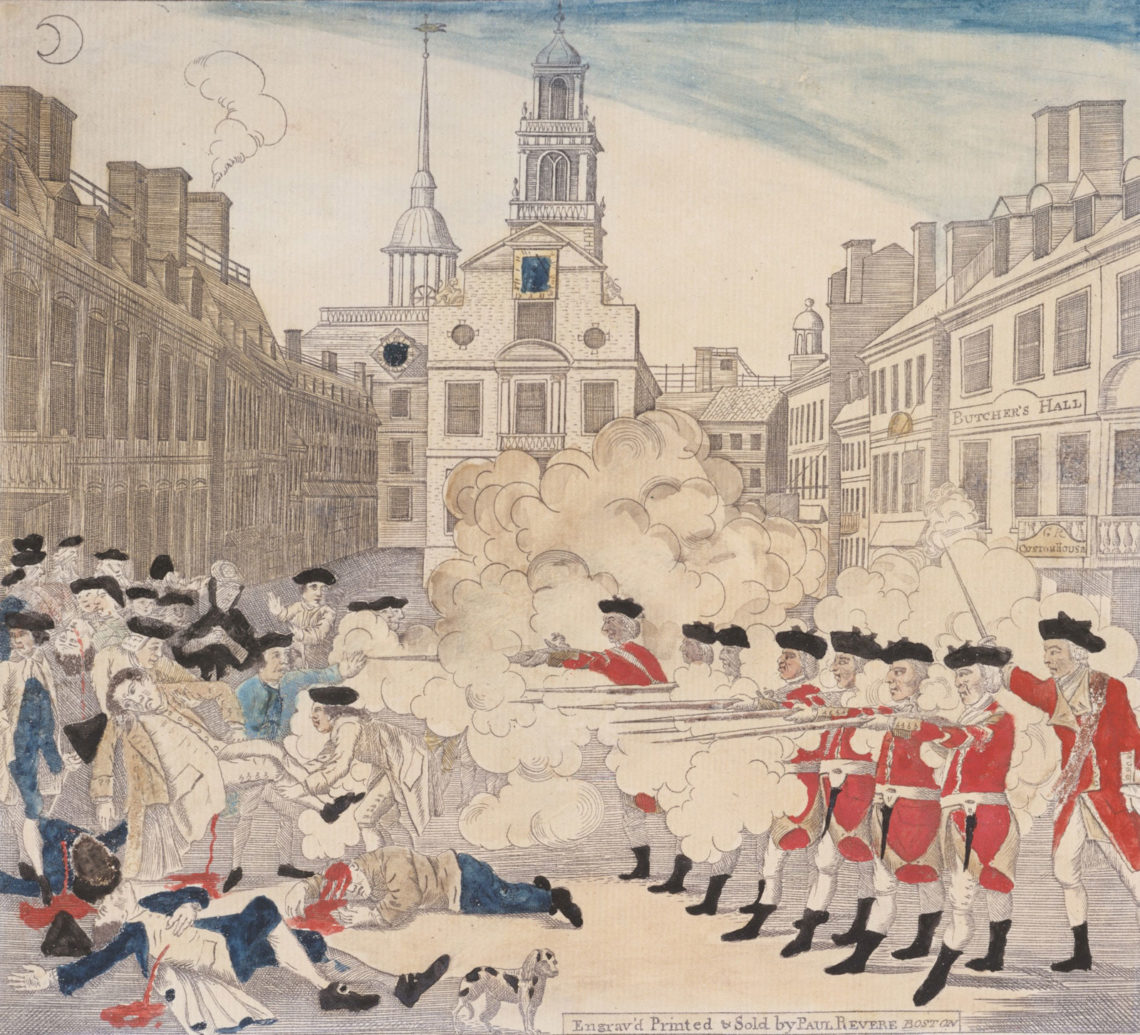
In 1773, the Boston Tea Party, involved the British crown trying to overtax the colony on tea brought by The East India Company, and the Boston patriots, led by Sam Adams, dressed like Native Americans, broke open all 342 chests of tea and threw them overboard into the bay.
Here is an account of the evening from, George Hewes:
“It was now evening, and I immediately dressed myself in the costume of an Indian, equipped with a small hatchet, which I and my associates denominated the tomahawk, with which, and a club, after having painted my face and hands with coal dust in the shop of a blacksmith, I repaired to Griffin’s wharf, where the ships lay that contained the tea. When I first appeared in the street after being thus disguised, I fell in with many who were dressed, equipped and painted as I was, and who fell in with me and marched in order to the place of our destination…
“During the time we were throwing the tea overboard, there were several attempts made by some of the citizens of Boston and its vicinity to carry off small quantities of it for their family use. To effect that object, they would watch their opportunity to snatch up a handful from the deck, where it became plentifully scattered, and put it into their pockets…”
In 1774, Franklin’s beloved wife, Deborah, dies.
Tensions between the colonists and the crown continued to build. A Scotsman visiting his sister in North Carolina in 1775 observed the following:
“At present the martial law stands thus: An officer or committeeman enters a plantation with his posse. The alternative is proposed. Agree to join us [Whigs] and your persons and properties are safe . . . if you refuse, we are directly to cut up your corn, shoot your pigs, burn your houses, … and perhaps tar and feather yourself…”
The American Revolution erupted in Boston, when the British retaliated harshly for the actions of the Boston Tea Party, and the patriots fought back. They besieged the British in the city, with a famous battle at Breed’s Hill in Charlestown on June 17, 1775, which was lost by the colonists, and followed with a win at the Siege of Boston, forcing the British to evacuate the city on March 17, 1776.
While Franklin joined in the calling for independence, his son, William, remained a staunch Tory, who branded the patriots “intemperate zealots” and refused to resign his post as the Royal Governor of New Jersey. Later, William would spend two years in a colonial prison for opposing the revolution, and later became a leader of a loyalist group, which needless to say caused a schism in his relationship with his father.
The Chief, The Frenchmen, and the Gay General Recruit
In the revolutionary war, stories about British atrocities were themselves used as weapons of war. The Patriots’ near monopoly on American printing presses meant that reports of British and Hessian cruelty spread, and survived disproportionately. Patriots also engaged in brutal and irregular warfare. General John Sullivan waged a scorched-earth march against the Iroquois, using one-third of the total Continental fighting force.
George Washington himself planned the campaign, telling Sullivan:
“…The total destruction and devastation of their settlements and the capture of as many prisoners of every age, and sex as possible. It will be essential to ruin their crops now in the ground and prevent their planting more.”
General Sullivan followed Washington’s orders; his men put at least 41 Native American towns to the torch. They desecrated native graves, raped native women and mutilated native bodies for profit, and for sport.
One lieutenant, William Barton, sent a party of his men and wrote the following in his official journal:
“…to look for some dead Indians. The soldiers returned to camp having skinned two of them from their hips down for bootlegs: a pair for Barton’s commander, and the other for myself.”
The British hired 30,000 Hessians, from the German state of Hesse-Cassel to help fight, and General George Washington employed the assistance of a 20-year-old French aristocrat, the Marquis de Lafayette. Lafayette learned that the Continental Congress lacked funds for his voyage, so he bought the sailing ship Victoire with his own money. The two-month journey to the New World was marked by seasickness and boredom. The ship’s captain intended to stop in the West Indies to sell cargo, but Lafayette was fearful of arrest, so he bought the cargo to avoid docking at the islands. He landed on North Island near Georgetown, South Carolina on 13 June 1777.
General George Washington, commander in chief of the Continental Army, came to Philadelphia to brief Congress on military affairs. Lafayette met him at a dinner on 5 August 1777; according to Leepson, “the two men bonded almost immediately.” Washington was impressed by the young man’s enthusiasm and was inclined to think well of a fellow Mason; Lafayette was simply in awe of the commanding general. General Washington took the Frenchman to view his military camp; when Washington expressed embarrassment at its state and that of the troops, Lafayette responded, “I am here to learn, not to teach.”
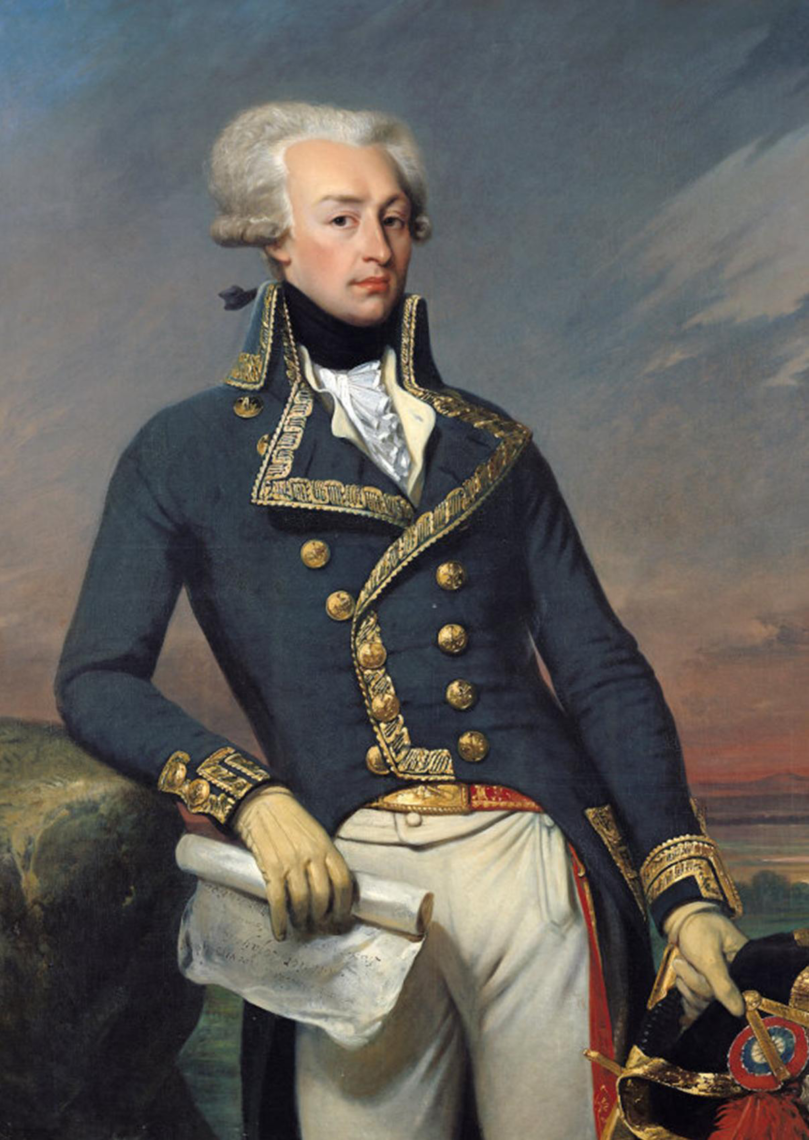
Lafayette as a lieutenant general in 1791; portrait by Joseph-Désiré Court
He became a member of Washington’s staff, although confusion existed regarding his status. Congress regarded his commission as honorary, while he considered himself a full-fledged commander who would be given control of a division when Washington deemed him prepared. Washington told Lafayette that a division would not be possible as he was of foreign birth, but that he would be happy to hold him in confidence as “friend and father.” After Lafayette returned to France, he named his first son, Georges Washington Louis Gilbert de La Fayette.
Washington also solicited help from the only one of the five Iroquois nations in support of the Patriots, the Oneida Nation. The Oneida Nation was led by Peter Agwrongdougwas, or as he was later known, “Good Peter.”
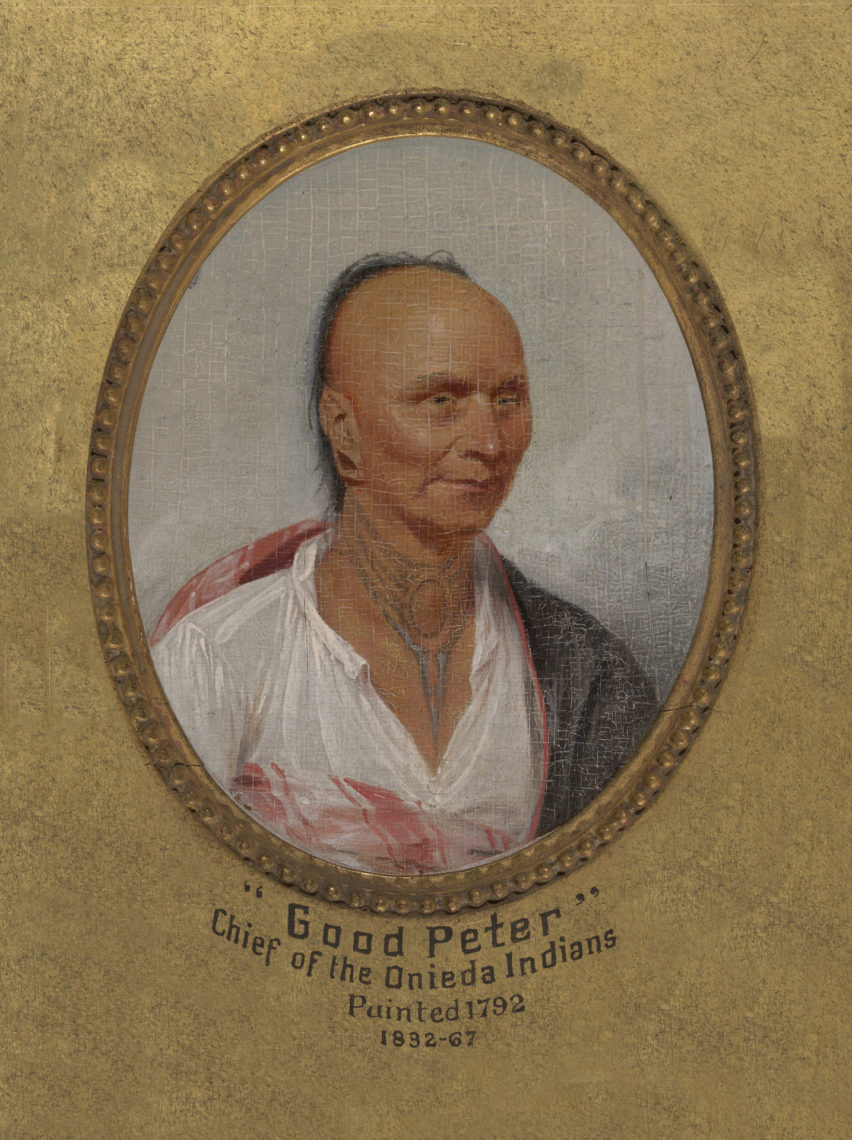
Painting by John Trumbul, 1792
Ben Franklin suggested the additional assistance of General Baron Friedrich von Steuben, a Prussian military officer hired by Washington to whip the Continental Army into shape during the darkest days of the war. He was known for his bravery and the discipline and grit he brought the American troops, and for the fact that he was openly homosexual, and served as an openly gay man in the military at a time when sex between men was punishable as a crime.

Friedrich Wilhelm von Steuben, by Charles Willson Peale
Franklin didn’t see von Steuben’s private life as relevant to his military qualifications. Neither did George Washington, who knew of the accusations, but welcomed von Steuben to his camp, where he assigned Alexander Hamilton and John Laurens—both of whom were involved in what some historians have dubbed a “romantic friendship”—as his aides.
Von Steuben could only speak and write a small amount of English, so he wrote the drills in German, the military language of Europe at the time. His secretary, Du Ponceau, would then translated the drills from German into French, and a secretary for Washington translated the French into English. They did this every single night in order that Washington could command his soldiers the following morning.
Colonel Alexander Hamilton and General Nathanael Greene were of great help in assisting Steuben to draft a training program for the Army. The Baron’s willingness and ability to work with the men, as well as his use of profanity (in several different languages), made him very popular among the soldiers. It is at this time he met his reputed future lover, Captain Benjamin Walker. Upon meeting Walker, he exclaimed, “If I had seen an angel from Heaven I should not have more rejoiced.” Within weeks, Walker was Steuben’s aide-de-camp.
Before the war actually began, the native people wanted to remain neutral. They viewed it as a fight between brothers, but all too soon they were brought into the conflict. Five of the native nations aligned with the British, with the exception, the Oneidas, who chose to align with the colonists. The Oneida warriors were the most experienced in “forest warfare.” Further, they offered intelligence, supplies, and seasoned warriors to the Patriots.
In 1777, the Oneida warriors fought bravely in one the bloodiest battles. The English sent troops, Loyalists, Hessians, and Native warriors to Albany to try and divide New England. At the Battle of Oriskany, State of New York, Mohawks & Senecas fought with the British. About 90 Oneida warriors & some Tuscarora fought brother against brother. The Loyalists won the battle.
Later in September 1777, in Saratoga, the Oneida chief sent 150 men, and they defeated the British. It was at this time that the French sent, money, troops, and naval assistance.
At Valley Forge in 1778, with the Patriots exhausted and freezing, Washington sent once again for the Oneida’s assistance. Chief Good Peter sent 75-100 warriors, traveling 300 miles to help the threadbare Patriots.
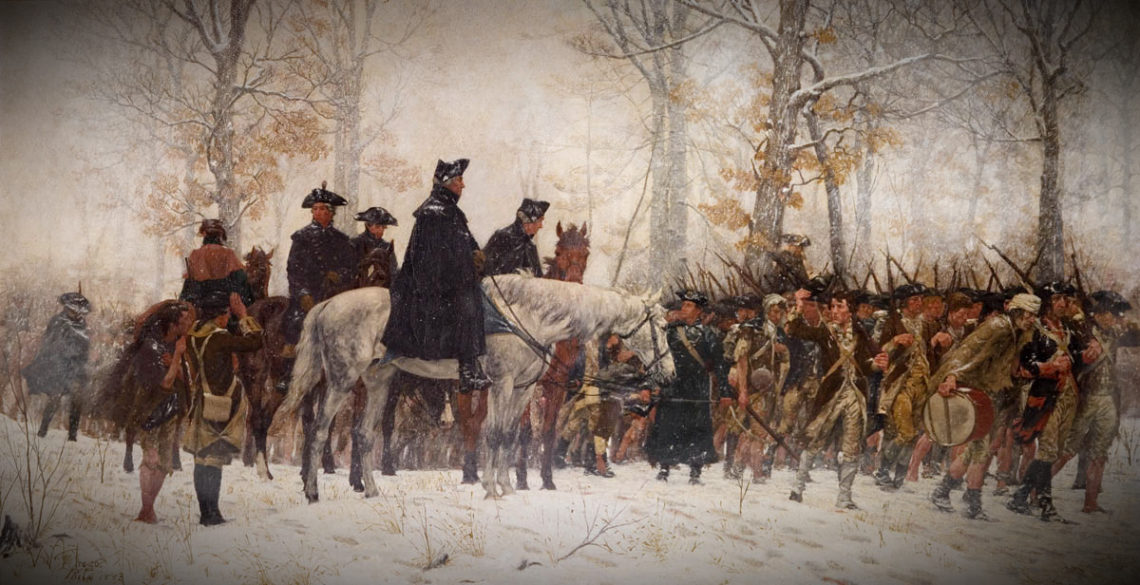
by Adam Asar
In the summer of 1780, the British destroyed all of the Oneida villages in retaliation.
The same year at Yorktown, the French helped defeat the British, and this serves as the tipping point of the war allowing the Patriots to ultimately succeed.
George Washington invited the Oneida chiefs to be present at war end. Continental Congress recognized them with theses moving words:
“We have experienced your love, strong as the oak, in your fidelity unchangeable as truth. You’ve kept fast the ancient covenant chain and preserved it free from rust and decay, and bright at silver. While the sun and the moon continue to give light to the world, we shall love and respect you. As our trusty friends we shall protect you and shall at all times consider your welfare as our own.”
The Oneida Nation had lost one-third of their population. The other Iroquois nations who supported the British were told their lands were lost, as having been defeated in the conquests of war. The United States gave assurances to the Oneida in 1794 in the Treaty of Canandaigua confirming the Oneida rights to their lands in perpetuity, as “America’s first allies.”
Article 2, which ensured the land rights of the Oneida, Onondaga, and Cayuga nations would be protected by the U.S. government against state interference, was ultimately dishonored. By the early 1800s, Federal Indian Agents were deeply involved in furthering a federal policy of depriving the Oneida people of their Article 2 rights by both failing to prevent the state of New York from purchasing the treaty lands, and actively encouraging the removal of the Oneidas to the west.
By 1920, the Oneida Nation retained only 32 acres of treaty land down from the six million acres held before the American Revolution.
————
When the war ended, Baron von Steuben was granted U.S. citizenship and moved to New York with, William North, who later married and became a New York Senator and U.S. District Judge for the District of New York,appointed by George Washington, and Captain Benjamin Walker, who later served as a U.S. Representative from New York. “We love him,” North wrote, “and he deserves it, for he loves us tenderly.”
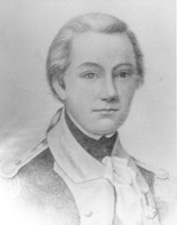
After the war, von Steuben legally adopted both men—a common practice among gay men in an age before same-sex marriage was legal. They lived together, managed his precarious finances, and inherited his estate when he died in 1794.
In 1825, the Marquis de Lafayette returned to the United States for a visit, and was stunned by the absence of the Oneida people.
In 1988, the United States Congress enacted the Gaming Regulatory Act that allowed Native Americans to have Tribal casinos. With the money generated—mostly from non-Native American gamblers, mindlessly feeding quarters, with George Washington’s head gleaming in the garish lights overhead—the Oneida people were able to buy back some of their traditional lands on the “open market.”
Franklin’s Greatest Achievement
Thomas Jefferson wrote the first draft of the Declaration of Independence July 4, 1776. Franklin, and three others assisted, making a total of 86 changes to the first draft.
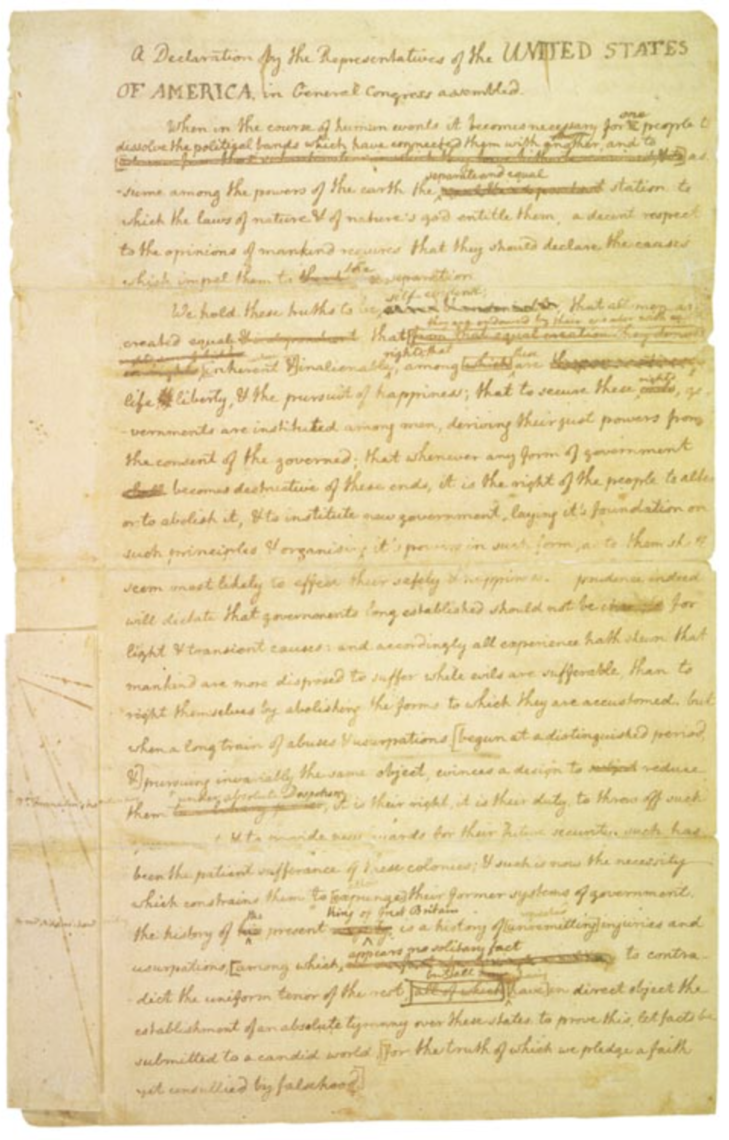
Then, Franklin served from 1776 to 1778 on a commission to France, charged with the critical task of gaining French support for American independence.
Despite never running for elected office, he served as a delegate to the Continental Congress and the Constitutional Convention, diplomat and ambassador to France and Sweden, the first Postmaster Generaland the President of the Supreme Executive Council of Pennsylvania.
Benjamin Franklin is the only founding father to have signed all four of the key documents establishing the sovereignty of the United States of America: the Declaration of Independence (1776), the Treaty of Alliance with France (1778), theTreaty of Paris, establishing peace with Great Britain (1783), and the United States Constitution (1787).
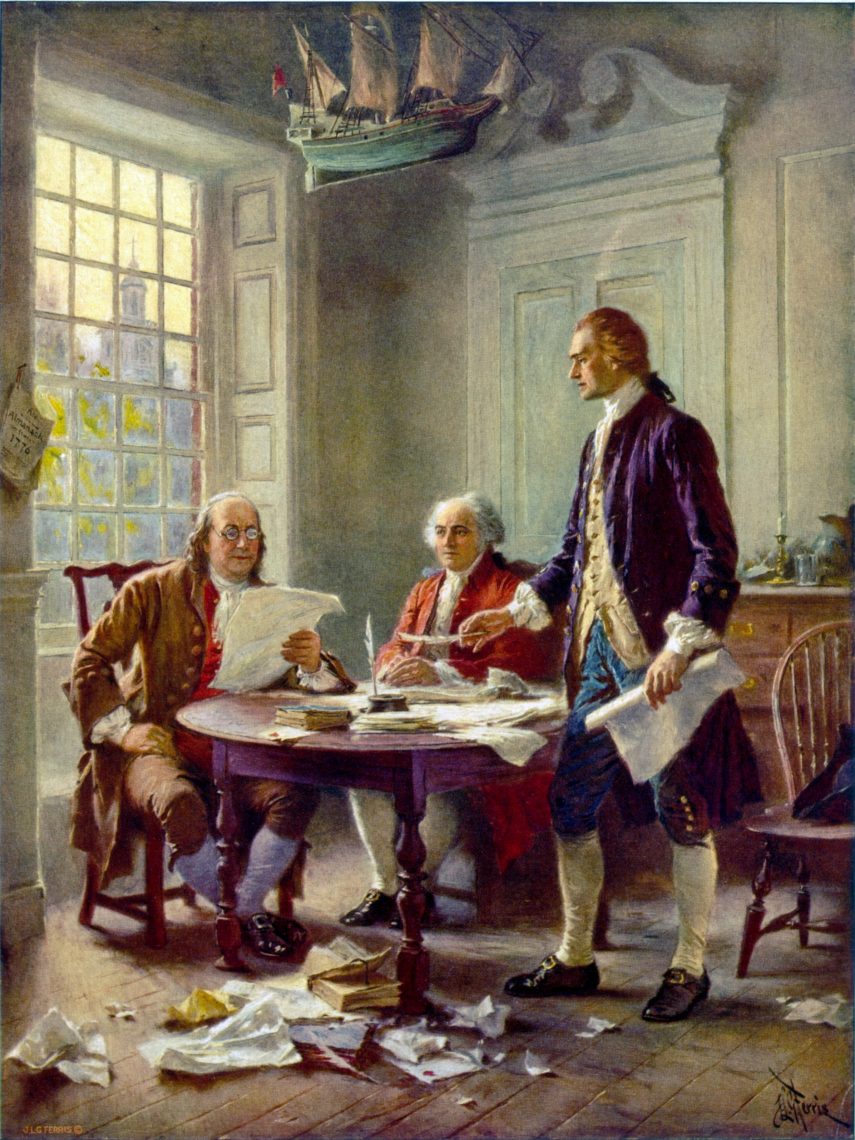
by Jean Leon Gerome Ferris
American painter 1863-1930, Philadelphia, Pa
When Franklin was influencing the formation, and signing of the U.S. Constitution, he referenced the Native American Iroquois model as he presented his Plan of Union at the Albany Congress in 1754, attended by representatives of the Iroquois and the seven colonies. He invited the Great Council members of the Iroquois Nation to address the Continental Congress in 1776. The Iroquois Confederacy, inspired by the Great Peacemaker in 1142, was the oldest known living participatory democracy on earth.
In 1744, the Onondaga leader Canassatego gave a speech urging the contentious 13 colonies to unite, as the Iroquois had at the signing of the Treaty of Lancaster, in which the Indians ceded nearly all of their vast conquered lands as well as ancestral land within and adjacent to the northern British colonies of North America. The land cessions covered most or all of the modern states of New York, Pennsylvania, western Maryland, Virginia and West Virginia, Kentucky, northeastern Ohio and extended marginally into northern Tennessee and North Carolina.
This cultural exchange inspired Benjamin Franklin to print Canassatego’s speech:
“We heartily recommend Union and a good Agreement between you our Brethren… “Never disagree, but preserve a strict Friendship for one another, and thereby you, as well as we, will become the stronger. Our wise Forefathers established Union and Amity between the Five Nations; this has made us formidable; this has given us great Weight and Authority with our neighboring Nations. We are a powerful Confederacy; and, by your observing the same Methods our wise Forefathers have taken, you will acquire fresh Strength and Power; therefore whatever befalls you, never fall out one with another.”
He used the metaphor that many arrows cannot be broken as easily as one. This inspired the bundle of 13 arrows held by an eagle in the Great Seal of the United States, and of course the sentiment, E Pluribus Unum, “United we are one.”
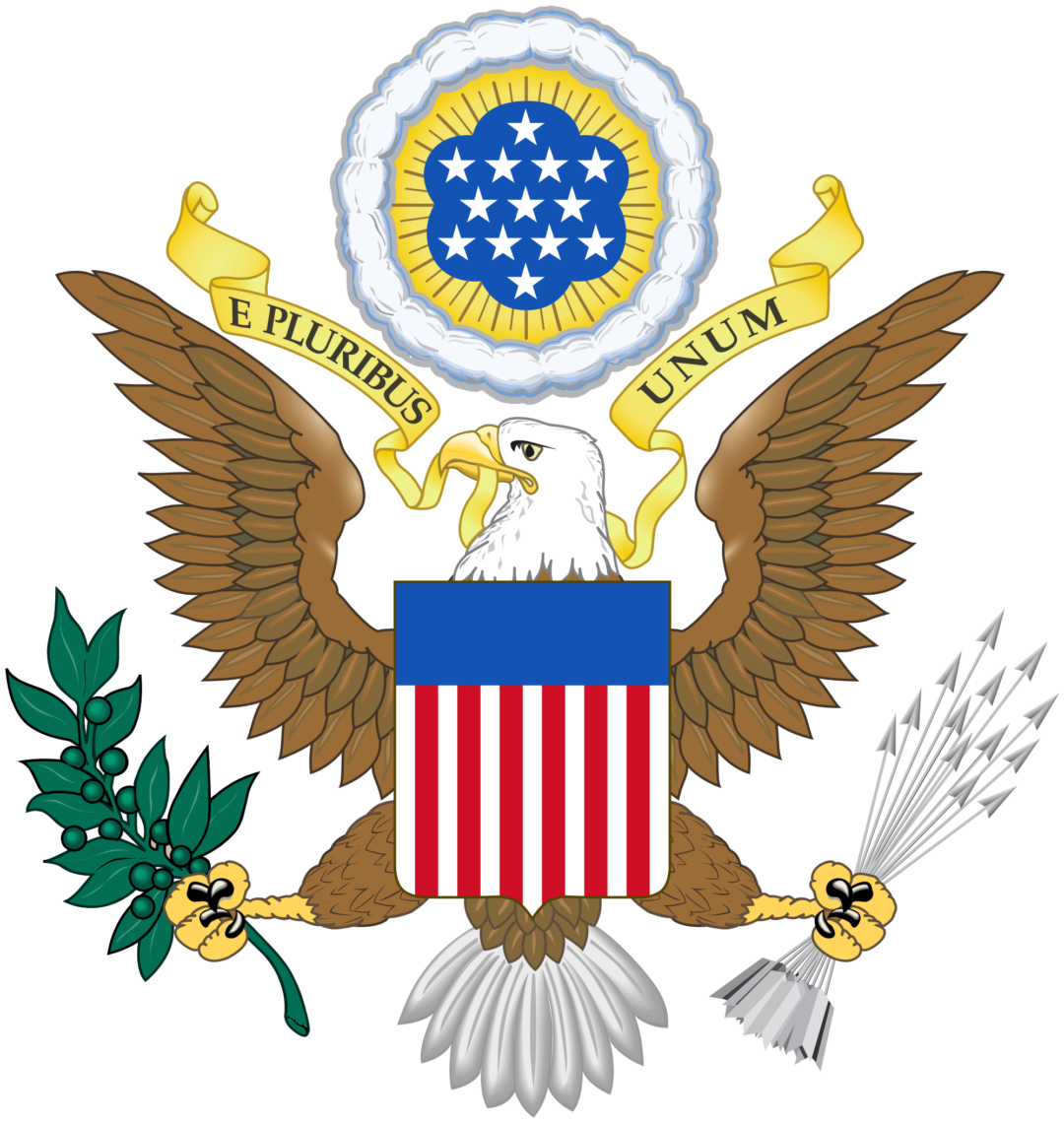
Slavery: Franklin Unresolved.
The year before Franklin died, he wrote the Anti-Slavery Treatise, and became the President of the Society for Promoting the Abolition of Slavery. The following comments, thanks to the work of Nikole Hannah-Jones, and Professor Gary B. Nash, best express this glaring unresolved matter of slavery:
“Before the abolishment of the international slave trade, 400,000 enslaved Africans would be sold into America. Those individuals and their descendants transformed the lands to which they’d been brought into some of the most successful colonies in the British Empire. Through backbreaking labor, they cleared the land across the Southeast. They taught the colonists to grow rice. They grew and picked the cotton that at the height of slavery was the nation’s most valuable commodity, accounting for half of all American exports and 66 percent of the world’s supply. They built the plantations of George Washington, Thomas Jefferson and James Madison, sprawling properties that today attract thousands of visitors from across the globe captivated by the history of the world’s greatest democracy. They laid the foundations of the White House and the Capitol, even placing with their unfree hands the Statue of Freedom atop the Capitol dome. They lugged the heavy wooden tracks of the railroads that crisscrossed the South and that helped take the cotton they picked to the Northern textile mills, fueling the Industrial Revolution. They built vast fortunes for white people North and South”
–By Nikole Hannah-Jones AUG. 14, 2019
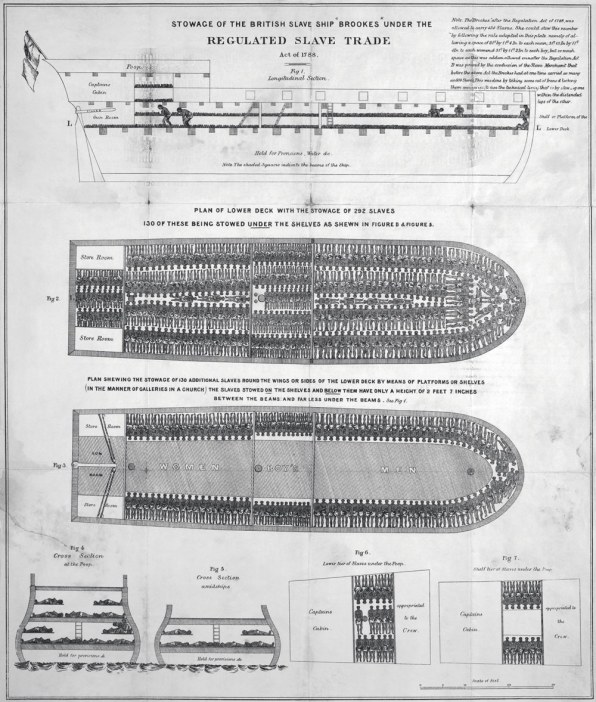
Franklin and his wife Deborah purchased slaves–Peter and Jemima–for the first time in the late 1740s, but he was uneasy about keeping them in the succession of small rented houses where the Franklins lived. Franklin believed that owning slaves diminished the master’s work ethic and ruined the white children in the families that owned them because they are “educated in idleness.” Yet, while rearing son William, the Franklins bought more slaves, named Othello, King and George. The last two were in tow when Franklin left for England with his 26-year-old son in 1757.
To Franklin’s dismay, King fled when his master was visiting outside London. King was later found in Suffolk in the service of a lady who had taught him to read and write and to play the violin and French horn. Franklin, who agreed to sell King to the woman, may have appreciated the slave’s newfound skills because, at the time, Franklin was revising his opinion about Africans’ capabilities. A few years later, after visiting an Anglican school for blacks in Philadelphia, he concluded:
“I was on the whole much pleased, and from what I then saw, have conceived a higher opinion of the natural capacities of the black race, than I had ever before entertained. Their apprehension seems as quick, their memory as strong, and their docility in every respect equal to that of white children.”
Despite such pronouncements, Franklin and his wife held on to their slaves. Like many other white colonists during the years leading up to the American Revolution, they grew to dislike slavery but not so much as to sacrifice their investments. When he returned to Philadelphia in May 1775, five months after Deborah died, Franklin passed along ownership of one slave, George, to his daughter Sally and her husband but kept Peter and Jemima at his side.
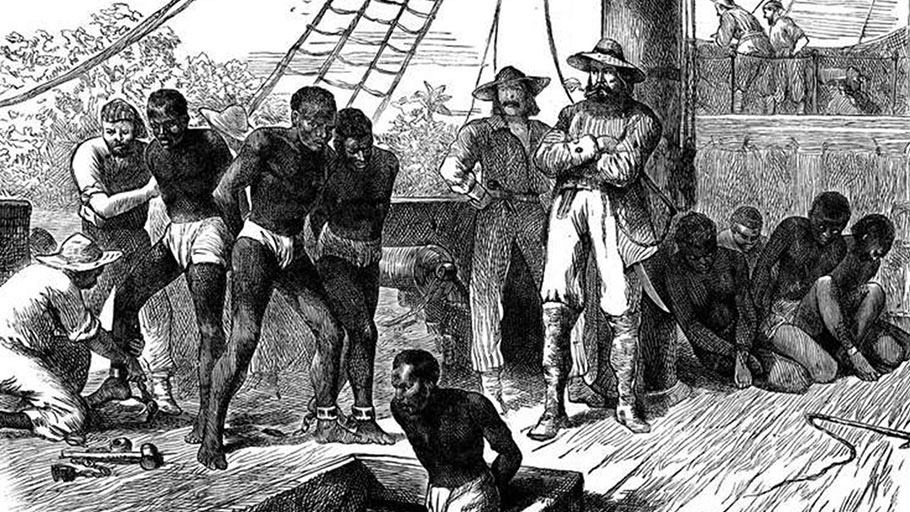
By his 81st birthday, Franklin was speaking openly against slavery. Accepting the ceremonial presidency of the Pennsylvania Abolition Society, he signed a public exhortation that declared “the Creator of the world” made “of one flesh, all the children of men.” Still, the surviving records from the Constitutional Convention give no indication that Franklin raised the issue.
Just before he died, Franklin had his last words on the subject in a biting parody. Signing the essay “Historicus,” Franklin composed a speech of one Sidi Mehemet Ibrahim, an Algerian prince, defending the practice of enslaving Christians. “If we forbear to make Slaves of [the Christians],” asked the prince, “who in this hot climate are to cultivate our lands? Who are to perform the common Labours of our City, and in our Families?” Yet Franklin’s rhetoric outpaced his actions. He had long ago revised his will to free Peter and Jemima at his death, but neither slave outlived him.
– Gary B. Nash is professor Emeritus of History at UCLA, and the author of Forging Freedom: The Formation of Philadelphia’s Black Community, 1720-184.
The Great Land Grab
For the Native Americans, to lose land, is to lose their very own identity and their complex sacred spiritual relationship with nature and their home for over 14,000 years. The British crown wanted territorial expansion, but they wanted it to be ordered and controlled, not wild and violent. For the American settlers, expansion and growth was essential for their identity, security, wealth, and to forge a greater a nation.
There was a Royal Proclamation of 1763, declaring the Appalachian Mountains as the official boundary between the English, and Indian Territory. Ben Franklin, George Washington, Patrick Henry, and Thomas Jefferson, all had investments in Native lands, and saw the expansion as a highly lucrative, and a shrewd assurance for building their wealth. Apparently, Native Americans, and the settlers, had very different concepts about land what constituted land “ownership.” For the Natives, the idea meant simply allowance to homestead, with the understanding that others can benefit and share the resources. To the settlers, it meant, “Stay off my land,” and no other people can use this land for their benefit. This concept made no sense to the Natives who felt themselves stewards of the earth, with no ownership, and shared everything amongst themselves as a tribe.

Land speculation was a natural and common preoccupation among the Founders. It meant the opportunity for great wealth.
“Hardly a prominent man of the period failed to secure large tracts of real estate, which could be had at absurdly low prices, and to hold the lands for the natural advance which increased population would bring,” wrote Albert J. Beveridge.
“I shall not rest contented till I have explored the western country, and traversed those lines which have given bounds to a New Empire,” – George Washington.
Washington’s fascination with the West began young and lasted a lifetime. The Library of Congress observed: “Between 1747 and 1799 Washington surveyed over two hundred tracts of land and held title to more than sixty-five thousand acres in thirty-seven different locations.” Land was the future. “Land is the most permanent estate and the most likely to increase in value,” wrote a youthful Washington.
Washington’s military ambitions during the period of French and Indian conflict had eventually transformed into an economic ambition to extend the land holdings he already made by inheritance, investment, and marriage.
Benjamin Franklin also understood the importance of land to the American economy. Franklin wrote:
“So vast is the Territory of North-America that it will require many Ages to settle it fully, and till it is fully settled, Labour will never be cheap, where no Man continues long a Labourer for others, but gets a Plantation of his own, no Man continues long a Journeyman to a Trade, but among those new Settlers, and sets up for himself, Etc.”
“Even before his mission to England, Franklin had dreamed of leading a colony to the Ohio, and during his English residence he had been involved in an abortive application for a grant of land.” Once in England in the 1760s, Franklin’s hope for a major land grant in Ohio kept in him in England. He worked on it for nearly a decade beginning in 1763. Franklin biographer Gordon S. Woods wrote: “When the Walpole partners first approached Hillsborough as secretary of the American Department, they asked for a grant of only 2.5 million acres for their company. Hillsborough told them that they were too modest: ask for 20 million acres, he suggested. This was a duplicitous suggestion, as Franklin later realized, but the Walpole speculators bought it and upped their request to 20 million acres – one of the biggest land grabs in world history…” –Alfred Owen Aldridge
Biographer Walter Isaacson noted that Franklin became “involved with a variety of partnerships, including ones called the Illinois Company and then the Indiana Company, that had failed to win support in London.
During the 1790s, the population west of the Appalachians more than doubled. Historian Arthur Burr Darling noted: “The estimated white population of the Northwest Territory in 1790 had been only 3,000, but there were some 15,000 by 1795: and the census of 1800 revealed a population in Ohio alone of 45,365.
(Visit The Lehrman Institute for an in depth look at this subject)
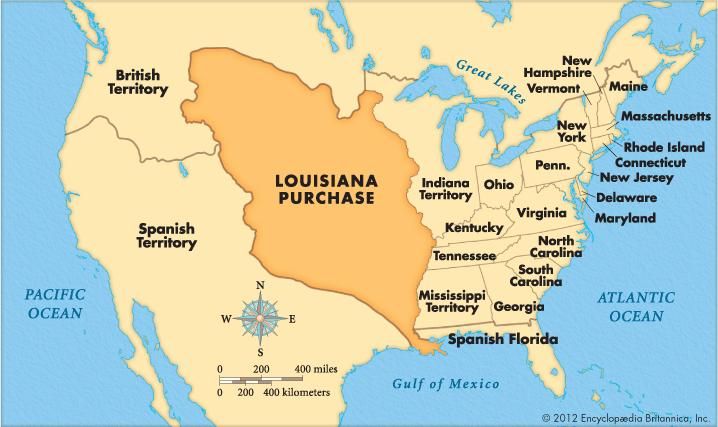
Post-Mortem Gift
On April 17, 1790, Benjamin Franklin died in Philadelphia, at age 84. An estimated 20,000 mourners attended his funeral service.
Franklin willed 2,000 pounds sterling to his birthplace of Boston and his adopted home of Philadelphia. The largesse came with an unusual caveat: for its first 100 years, the money was to be placed in a trust and only used to provide loans to local tradesmen. A portion could then be spent, but the rest would remain off limits for another 100 years, at which point the cities could use it as they saw fit.
Boston and Philadelphia followed Franklin’s wishes, and by 1990 their funds were worth $4.5 million and $2 million, respectively. The two towns have since used the windfall to help finance the Franklin Institute in Philadelphia and the Benjamin Franklin Institute of Technology in Boston. Philadelphia also put some of its funds toward scholarships for students attending trade schools.
Closing Thoughts
If my eyes are shut, I can imagine the United States of America before the Europeans arrived: the pristine rivers and lakes, and the sheer beauty of the land. I can appreciate the burden the so-called Puritans must have felt living in persecution under James I of England, and respect their bravery and courage to cross the Atlantic in search of a better life. I understand their desire to be rid of a king, and a class system that held people chained to their birth, born a prince or baker, the heavy weight of taxation, and the difficulty for a common man to own land. I honor their vision of a New World, a better world.
With that said, these so-called “Pilgrims” were invaders who felt themselves superior to the people they deemed as savages. They murdered and manipulated the Native Americans to gain their land, enslaved both natives and African slaves: whom they subjected to pain and suffering for a lifetime and owned as common chattel, subjugated all women allowing no rights, allowed little opportunity for personal expression or ideological disagreement, or sexual freedom outside of marriage. All this, they did in the name of “God.”
Early on, the equality of African-Americans was realized, and yet, the colonists intentionally kept them excluded from education, freedom, or the ability to participate politically, in a so-called democracy in which the authors had the audacity to write, “We hold these truths to be self-evident, that all men are created equal, that they are endowed by their creator with certain unalienable rights, that among these are life, liberty, and the pursuit of happiness.”
We, Anglo-Saxons, brought far more than our small pox, religious ideologies, and trinkets of manufactured goods. We arrived with centuries of war and bloodshed in our DNA. We arrived violent, ambitious, and entangled in the derelictions and schemes of a failed human state. I would comfortably argue that we remain very much in the same state of consciousness today.
From 1778 to 1871, the United States government entered into more than 500 treaties with the Native American tribes; all of these treaties have since been violated in some way or outright broken by the US government, while at least one treaty was violated or broken by Native American tribes. Today there are 574 recognized tribes in the U.S., speaking 150 languages. 1-in-3 Native Americans are living in poverty, and the Federal Government continues to find ways to manipulate the tribes for financial gain: mineral rights, gas and oil, water, and other issues.
When the Puritans arrived, the Iroquois Confederacy was on 24,894,080 acres. Today in Massachusetts there are four Native American reservations, and they currently hold 792 acres:
• Chaubunagungamaug (Worcester County): 2.5 acres
• Hassananisco Nipmuc (Worcester County): 4.5 acres
• Wampanoag Tribe of Gay Head (Martha’s Vineyard): 485 acres
• Mashpee Wampanoag Tribe (Barnstable County): 300 acres
We, “founding” Anglo-Saxon, French, and Spanish Europeans, arrived so certain of our own superiority, formulating that narrative as our mantra “superior and ordained by a Christian God” that within just a few generations, approximately 20 million native inhabitants died, 95% of the native population in the Americas from forced slavery, war defending their lands, and diseases we brought from Europe.
Interestingly, both Benjamin Franklin and Thomas Jefferson claimed to be Deists, asserts that reason and observation of the natural world are sufficient to establish the existence of a Supreme Being or creator… just like every Native American in the country lived for 14,000 years before our arrival.
Benjamin Franklin owned four slaves and was the President of the Pennsylvania Abolition Society, and didn’t free a soul, and Thomas Jefferson owned 600 slaves, and only gave freedom to seven individuals. Thomas Jefferson had a very serious love affair with one of his slaves, Sally Hemings, and she had six children with Jefferson, and he never gave Sally her freedom.
While our “Founding Fathers” were brilliant, philosophically well read, and innovative, they had every intention of placing their own wealth and welfare above all others. It seems that this “toxic male consciousness” brought over the Atlantic is still in full affect in the American experience.
Today, we hear our own president boast ad nauseam about how he is the greatest president the country has seen, and has done more for the people than any other president. What exactly is that?
On March 27, 2020, under the Trump Administration, the Tribal Council was informed by the Federal Bureau of Indian Affairs that reservation designation would be rescinded and, with the U.S. Department of the Interior, over 300 acres of land would be removed from the federal trust. Cedric Cromwell, the tribal chair, said this action is “unnecessary” and “cruel.”
“This is an existential crisis for tribes,” said Jean-Luc Pierite, of the North American Indian Center, a Boston-based advocacy group. On June 6, a US District Court ruling reversed the Department of Interior’s ruling ordered the DOI to maintain the reservation status of the tribe’s 321 acres of land until the department issues a new decision.
The newly arrived men aboard the Mayflower, having been blown off course, excitedly signed the “Mayflower Compact” agreeing to establish a self-governing community where everyman’s voice would be heard. This concept has changed over the centuries in the United States, where economic interests of large corporations supersede the needs and welfare of the community:
Lobbyists: there are over 12,000 lobbyists, spending over $3 billion dollars to influence policy.
PACs: In a campaign finance system where all the money originates from individuals, political action committees, or PACs, control the most “corporate” of money. Controlled by companies, trade associations, unions, issue groups and even politicians (a subset called “leadership PACs”), these committees pool contributions from individuals and distribute them to candidates, political parties and other PACs raise $4 billion dollars.
527s: These groups, formed under section 527 of the Internal Revenue Code, primarily were involved in issue advocacy and weren’t permitted to tell the public explicitly to elect or defeat a particular candidate – until the Supreme Court’s Citizens United decision in 2010. Now, they may engage in the full range of political activity, including asking the public to vote for or against a would-be officeholder. In 2018, they spent over $1 billion dollars. –Open Secrets.org
There is an ever-widening gap between the haves and the have-nots in the United States. CEO compensation has grown 940% since 1978. Typical worker compensation has risen only 12% during that time
-Economic Policy Institute
The same reasons that our forefathers fought the British for independence, high taxes and under representation are beginning to be the reality for the citizens of the United States.
In 2015, total federal revenues in fiscal year 2015 are expected to be $3.18 trillion.
These revenues come from three major sources:
- Income taxes paid by individuals: $1.48 trillion, or 47% of all tax revenues.
- Payroll taxes paid jointly by workers and employers: $1.07 trillion, 34% of all tax revenues.
- Corporate income taxes paid by businesses: $341.7 billion, or 11% of all tax revenues.
Big companies have long relied on strategies to reduce their tax bills. But the new tax law is making it even easier, with a new analysis finding that 60 profitable Fortune 500 companies paid no taxes on a total of $79 billion of profits earned in 2018. – CBS News Report
• Individuals in the United States who make over $600,000 annually must pay 37% income tax, yet Amazon will pay 0% in federal income tax this year, despite its profits soaring to $11.2 billion in 2018; nearly double the $5.6 billion it earned the previous year, ITEP said. In fact, Amazon claimed a federal income tax rebate of $129 million, the study found. It would be the second year in a row Amazon paid no federal tax, giving the retail giant an effective tax rate of -1 percent.
• Are we at war? Is the United States of America in danger of being attacked? Estimated U.S. military spending is $934 billion. It covers the period October 1, 2020, through September 30, 2021. Military spending is the second-largest item in the federal budget after Social Security. This figure is more than the $705 billion outlined by the Department of Defense.
• Half of the world’s net wealth belongs to the top 1%, and the top 10% of adults hold 85%
• Many of our citizens are feeling overwhelmed. Suicide is the 10th cause of death in the United States:
• 16% percent of young Native Americans reported attempting suicide
• White middle-aged males accounted for 69.67% of suicide deaths in 2018.
• Our current United States president, Donald J. Trump, as been involved in 3,500 law suits, Trump or one of his companies were plaintiffs in 1,900; defendants in 1,450; and bankruptcy, third party, or other in 150. Trump was named in at least 169 suits in federal court.
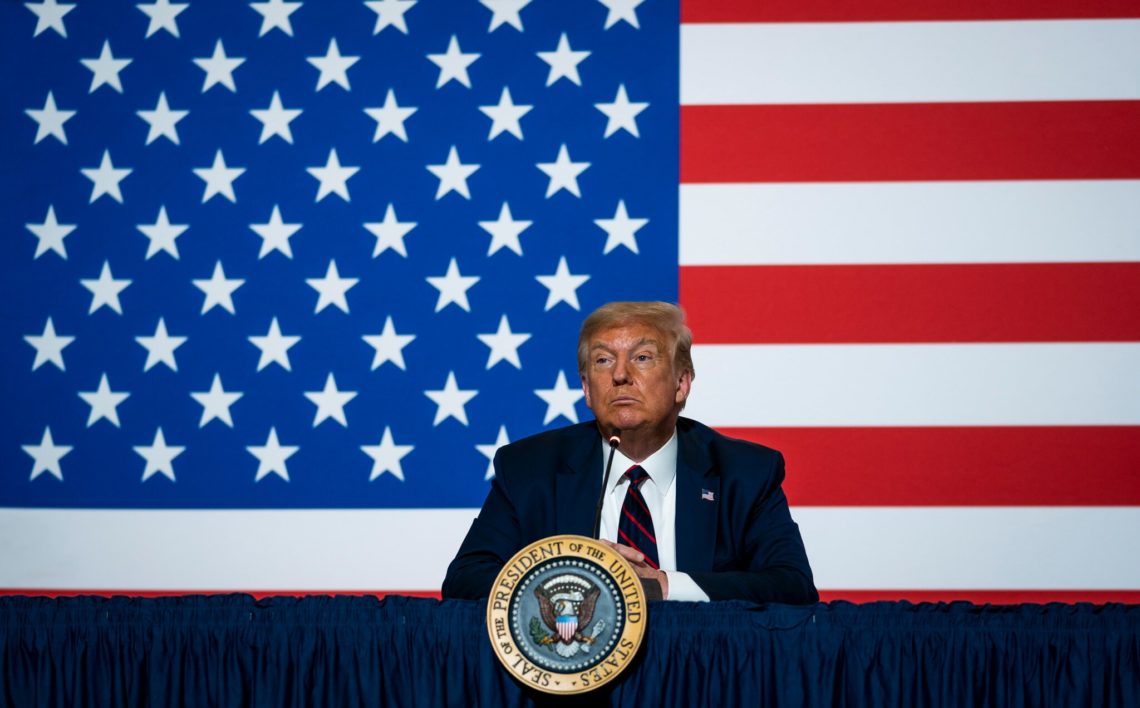
• Roy Cohn, Donald Trump’s Attorney and Mentor 1973-1985 disbarred from practicing law:
Cohn aided Roger Stone in Ronald Reagan’s presidential campaign in 1979–1980, helping Stone arrange for John B. Anderson to get the nomination of the Liberal Party of New York, a move that would help split the opposition to Reagan in the state. Stone said Cohn gave him a suitcase that Stone avoided opening and, as instructed by Cohn, dropped it off at the office of a lawyer influential in Liberal Party circles. Reagan carried the state with 46 percent of the vote. Speaking after the statute of limitations for bribery had expired, Stone said, “I paid his law firm. Legal fees. I don’t know what he did for the money, but whatever it was, the Liberal Party reached its right conclusion out of a matter of principle.”
Following federal investigations during the 1970s and 1980s, Cohn was charged three times with professional misconduct, including perjury and witness tampering, and he was accused in New York of financial improprieties related to city contracts and private investments. He was acquitted on all charges. In 1986, a five-judge panel of the Appellate Division of the New York State Supreme Court disbarred Cohn for unethical and unprofessional conduct, including misappropriation of clients’ funds, lying on a bar application, and pressuring a client to amend his will. –Source: Wikipedia
• Michael Cohen, Donald Trump’s attorney 2006-2018 disbarred from practicing law:
Cohen was a vice-president of The Trump Organization, and the personal counsel to Trump, and was often described by media as Trump’s “fixer”. He served as co-president of Trump Entertainment and was a board member of the Eric Trump Foundation, a children’s health charity. From 2017 to 2018, Cohen was deputy finance chairman of the Republican National Committee.
Trump employed Cohen until May 2018, a year after the Special Counsel investigation into Russian interference in the 2016 United States elections began. The investigation led him to plead guilty on August 21, 2018, to eight counts including campaign finance violations, tax fraud, and bank fraud. Cohen said he violated campaign finance laws at the direction of Trump and “for the principal purpose of influencing” the 2016 presidential election. In November 2018, Cohen entered a second guilty plea for lying to a Senate committee about efforts to build a Trump Tower in Moscow. –Source: Wikipedia
• Roger Stone: Convicted criminal, and advisor to Donald Trump.
A longtime friend of Donald Trump, Stone has been variously described as a “self-proclaimed dirty trickster”, a “renowned infighter”, a “seasoned practitioner of hard-edged politics”, a “mendacious windbag”, a “veteran Republican strategist”, and a political fixer. Over the course of the 2016 Trump presidential campaign, Stone promoted a number of falsehoods and conspiracy theories. He has described his political modus operandi as “Attack, attack, attack – never defend” and “Admit nothing, deny everything, launch counterattack.” Stone first suggested Trump run for president in early 1998 while he was Trump’s casino business lobbyist in Washington.The Netflix documentary film Get Me Roger Stone focuses on Stone’s past and his role in Trump’s presidential campaign.
Stone officially left the Trump campaign on August 8, 2015; however, two associates of Stone have said he collaborated with WikiLeaks founder Julian Assange during the 2016 presidential campaign to discredit Hillary Clinton. Stone and Assange have denied these claims. Nearly three-dozen search warrants were unsealed in April 2020, which revealed a web of contacts between Stone, Assange, and other key 2016 Russian interference figures, and that Stone orchestrated hundreds of fake Facebook accounts and bloggers to run a political influence scheme on social media. On January 25, 2019, Stone was arrested at his Fort Lauderdale, Florida, home in connection with Robert Mueller’s Special Counsel investigation and charged in an indictment with witness tampering, obstructing an official proceeding, and five counts of making false statements. Stone was convicted on all seven-felony counts in November 2019 and was sentenced to 40 months in prison. On July 10, 2020, days before he was scheduled to report to federal prison, Trump commuted Stone’s sentence. – Source: Wikipedia
——–
I am reminded of the words of Thomas Jefferson, chief architect of our democracy, and our third president:
“When once a Republic is corrupted, there is no possibility of remedying any of the growing evils but by removing the corruption and restoring its lost principles; every other correction is either useless or a new evil…
…The people are the ultimate guardians of their own liberties. In every government on earth is some trace of human weakness, some germ of corruption and degeneracy . . . Every government degenerates when trusted to the rulers of the people alone.”
If Benjamin Franklin were alive today, I sense he would be appalled by the State of the Union. While he was no saint, and certainly wanted to reap the bounty of the New World, as we all do, he was above all, a man who used his intellectual acumen to try and solve obvious problems in an even, and pragmatic manner.
I am not suggesting that we, as a nation, should abandon our Constitution. On the contrary, I am reconfirming essential importance as a framework for justice. I am suggesting that our Republic will be in certain decline if we do not remain true to it’s original spirit, in spite of the abuses and shortcomings of the very men who drafted it, and who have been charged with the responsibility to protect it. Yes, let us reinvigorate the absolute truth that all men are created equal, that they are endowed by their creator with certain unalienable rights, that among these are life, liberty, and the pursuit of happiness.
We might seriously consider changing the name of our Thanksgiving holiday into a day of Peace, Prayer, & Forgiveness. An opportunity to give us, as a nation, a point of healing to move forward together… for all the Native Americans we cheated, killed, and stole their lands, the tens of millions of African Americans who’s forefathers gave their sweat, blood, and lives for the benefit of this nation. For all the Chinese Americans who toiled building our railway in the Northwest. For all the miners that lost their lives giving us coal to stay warm. For all the women in America who endured hell in abusive marriages, couldn’t vote, and had not legal rights. For all the LBGT Americans who could not celebrate their love openly, and often were murdered. For the tens of thousands of Mexican Americans who toiled in fields in California without appropriate pay for decades, to feed Americans. And, for all the other people, both in our country and beyond, who have suffered injustices, especially caused by our government engaging in war.
It’s curious to me, that in many respects this nation is in a similar condition that precipitated and inspired our founding fathers to leave Europe 400 years ago. Is that why Elon Musk is developing private space travel? Has it really come to that? Because it we do colonize in space, we will simply bring the same bad habits with us. Better that we figure it out here first!
In God We Trust.
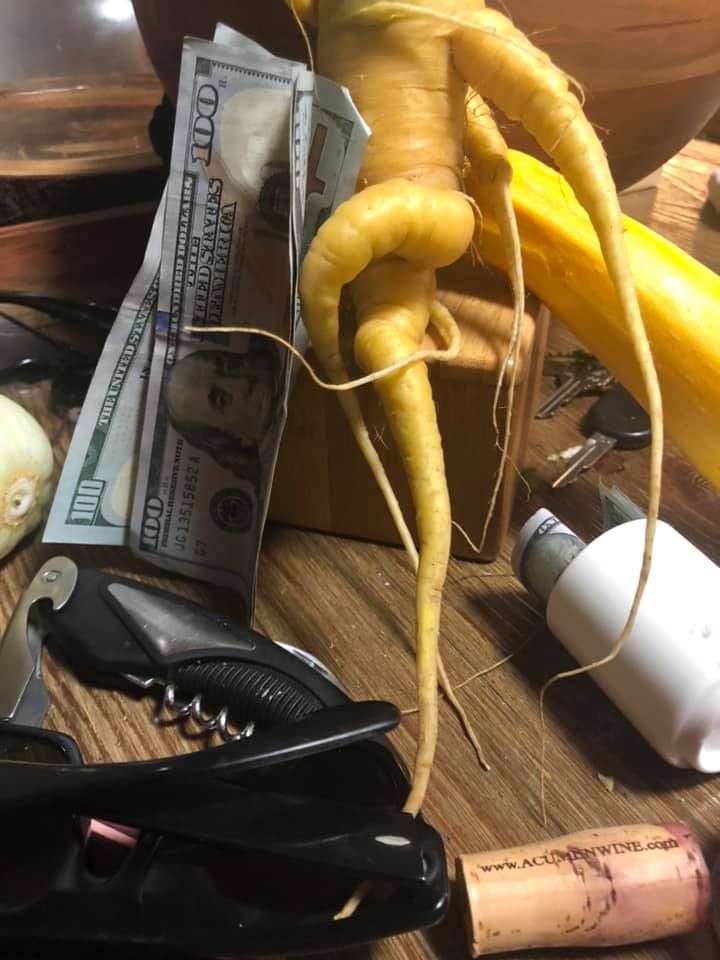
Original Art © 2020
by Micheal Brantley
Special thanks to scholars: Gary B. Nash, Larry Kramer, Gordon S. Woods, Albert J. Beveridge, Arthur Burr Darling,Lori Stokes, Walter Isaacson, Vincent N. Parrillo, Nikole Hannah-Jones, Holger Hoock, and Terri Hansen. Also to Wikipedia, Encyclopedia Britannica, The Lehrman Institute, Multiple documentaries on YouTube, Ric Burns, “Oneida Nation: American Revolutionary War/The People of the Standing Stone.” the series “Jamestown” on Netflix, and the countless other historical contributors who work so hard to write articles to illuminate interesting aspects of our past. The sharing of information truly does make the world a richer place.